Bali, Indonesia
Bali is one of the most famous island in the Indonesian archipelago. The island’s home to an ancient culture that's known for its warm hospitality.
Over the years, the grace and charm of Bali and its people have earned this tiny Indonesian island numerous sobriquets of praise and homage including Island of the Gods, The Last Paradise, Land of a Thousand Temples, and Morning of the World.
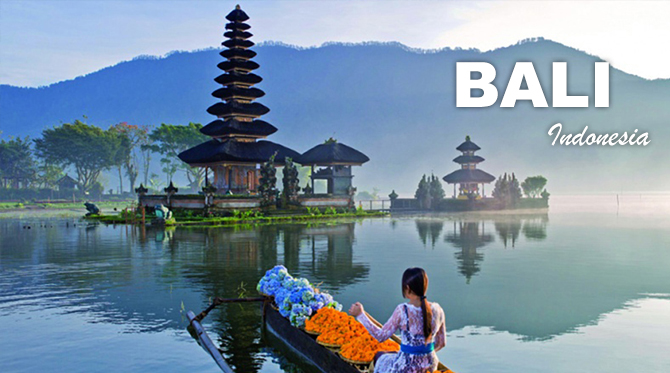
Varied landscape of hills and mountains, rugged coastlines and sandy beaches, lush rice terraces and barren volcanic hillsides all providing a picturesque backdrop to its colourful, deeply spiritual and unique culture, stakes a serious claim to be paradise on earth.
World-class surfing and diving, a large number of cultural, historical and palaces set against stunning natural backdrops are some of its top attractions which Bali as the world's top destination.
Bali has something to offer a very broad market of visitors from young back-packers right through to the super-rich.
Amazing beach resorts and luxury resorts in any of Bali’s famous areas. These include Kuta, Jimbaran, Seminyak, Tanjung Benoa, Candidasa, Lovina, Sanur and Nusa Dua where most of the great hotels and villas are right on the beach.
Bali also offers plenty for adventure-seekers. From white water rafting, diving, volcano hiking, jungle trekking, water sports, cycling, and much more.
There are many more off-the-beaten-track spots around this magical island worth discovering.
We are going to inform everything you need to know about Bali Indonesia including history, culture, geography, language, foods, visa, religion, life style, tourism and much more. But feel free to jump to any section that interests you:
Bali Province
Bali is a province of Indonesia and is approximately 153km wide and 112km high with a total land area of approximately 5,780 square km (2,231 square miles).
The province includes the island of Bali and a few smaller neighbouring islands, such as Nusa Penida, Nusa Lembongan and Nusa Ceningan.
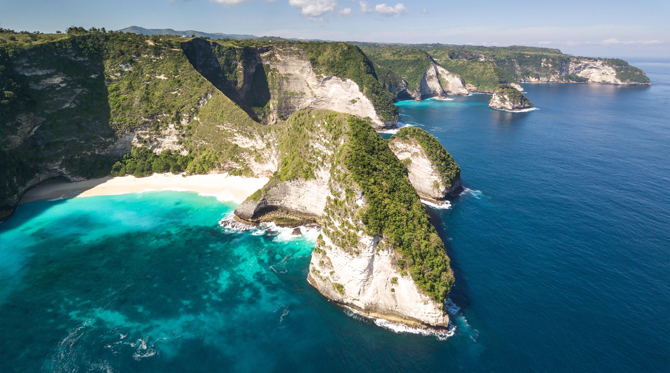
Denpasar is Bali's largest and capital city and is located in the south of Bali, which situated 1 mile (1.6 km) east of the island of Java, separated by the narrow Bali Strait. Area province, 2,232 square miles (5,780 square km).
Bali Location & Map
Bali is a popular holiday destination and many people have heard of it, but there are people who still ask 'where is Bali?'
Bali is an island of Indonesia and is situated 8 degrees from the equator, in the Java Sea.
Bali's location is 4,555 km (2,830 miles) from Australia and is situated between Indonesia's islands of Lombok and Java.
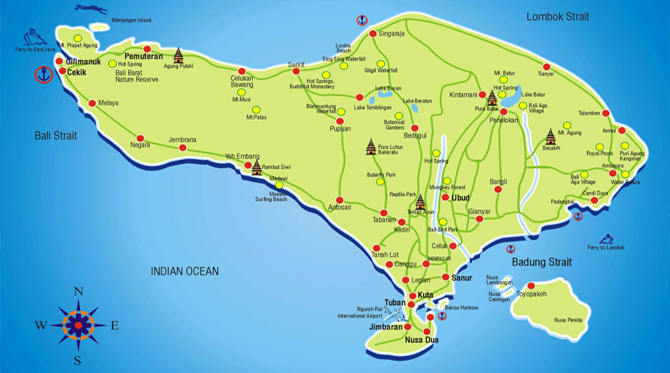
Bali is a province of Indonesia and is approximately 153km wide and 112km high with a total land area of approximately 5,780 square km (2,231 square miles).
And Denpasar is Bali's largest and capital city and is located in the south of Bali.
Bali is located to the north of Australia, the south of Malaysia, the south east of Singapore and the south west of Indonesia.
Bali has a population of approximately 4.22 million with the majority of people following the religion of Balinese Hinduism and the remainder following a mostly Islamic religion although there are also other religions observed on the island including Christianity.
Bali's main ethnic groups include Balinese, Javanese, Madurese and Baliaga.
Bali is Indonesia's largest and most popular tourist destination and continues to attract thousands of tourists each year with its highly developed art, culture and leisure scenes.
The main regions of Bali include Ubud, Kuta, Seminyak, Legian, Nusa Dua and Sanur. Close to the centre of Bali, Ubud is considered the island's cultural hub while Kuta in the south is Bali's party destination.
Seminyak is a southern coastal destination that is a major tourist hub, as is Legian a little further south.
Nusa Dua is located on the south east coast and offers a high end atmosphere while Sanur boasts absolute peace and luxury just outside of Denpasar.
With such a wealth of history, art, culture and spectacular natural attractions, the important question to ask is not 'where is Bali?' but rather, 'when can I go to Bali?'
Bali History
The history of Bali covers a period from the Paleolithic to the present, and is characterized by migrations of people and cultures from other parts of Asia.
In the 16th century, the history of Bali started to be marked by Western influence with the arrival of Europeans, to become, after a long and difficult colonial period under the Dutch, an example of the preservation of traditional cultures and a key tourist destination.
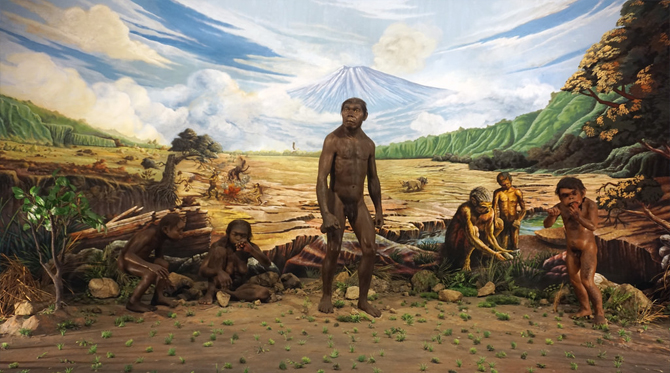
Bali being part of the Sunda shelf, the island had been connected to the island of Java many times through history. Even today, the two islands are only separated by a 2.4 km Bali Strait.
The ancient occupation of Java itself is accredited by the findings of the Java man, dated between 1.7 and 0.7 million years old, one of the first known specimens of Homo erectus.
Bali also was inhabited in Paleolithic times (1 my BCE to 200.000 BCE), testified by the finding of ancient tools such as hand axes were found in Sembiran and Trunyan villages in Bali.
A Mesolithic period (200.000-30.000 BCE) has also been identified, characterized by advanced food gathering and hunting, but still by Homo Erectus.
Neolithic: Austronesian migrations (3000-600 BCE)
From around 3000 to 600 BCE, a Neolithic culture emerges, characterized by a new wave of inhabitants bringing rice-growing technology and speaking Austronesian languages.
These Austronesian peoples seem to have migrated from South China, probably through the Philippines and Sulawesi. Their tools included rectangular adzes and red slipped decorated pottery.

Forests and jungles were cleared for the establishment of cultures and villages.They also made some plaited craft and a small boat was also found.
Their culinary habits included pork-eating and betel-chewing. They are thought to have focused on mountain cults.
They buried some of their more prestigious dead in oval stone sarcophagi, with human heads or zoomorphic figures sculpted on them. The bodies were either deposited in the sleeping position, or folded in two or three for compactness.
An important neolithic archaeological site in Bali is that of Cekik, in the western part of the island.
These same Austronesian people are thought to have continued their expansion eastward, to occupy Melanesian and Polynesian islands around 2000 years ago.
The cultural traits of this period are still clearly visible in the culture of Bali today, and connect it to the cultures of Southeast Asia and the Pacific Ocean.
Bronze Age: arrival of Dong Son culture (600 BCE-800 CE)
A Bronze Age period follows, from around 600 BCE to 800 CE. Between the 8th and 3rd century BCE, the island of Bali acquired the "Dong Son" metallurgical techniques spreading from Northern Vietnam.
These techniques involved sophisticated casting from moulds, with spiral and anthropomorphic motifs.
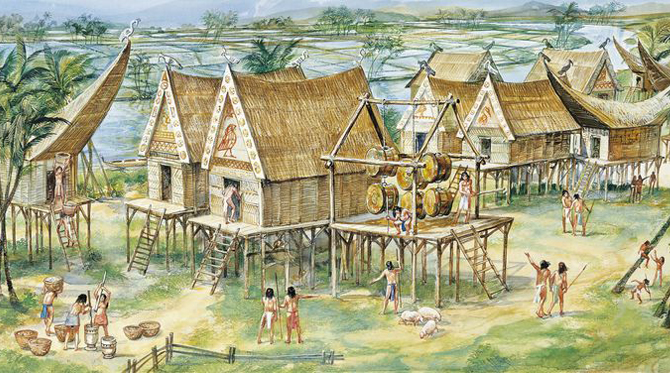
As mould fragments have been found in the area of Manuaba in Bali, it is thought that such implements were manufactured locally rather than imported.
The raw material to make bronze (copper and tin) had to be imported however, as it is not available on Bali.
Numerous bronze tools and weapons were made (axes, cooking tools, jewellery), and ceremonial drums from that period are also found in abundance, such as the "Moon of Pejeng", the largest ceremonial drum yet found in Southeast Asia, dated to around 300 BCE.
The stone sarcophagi were still in use during that period, as bronze artefacts were also found in them.
Ancient historical period: Indianized kingdoms (800-1343 CE)
The ancient historical period is defined by the appearance of the first written records in Bali, in the form of clay pallets with Buddhist inscriptions.
These Buddhist inscriptions, found in small clay stupa figurines (called "stupikas") are the first known written inscriptions in Bali and date from around the 8th century CE.
Such stupikas have been found in the regency of Gianyar, in the villages of Pejeng, Tatiapi and Blahbatuh.
This period is generally closely associated with the arrival and expansion of Buddhism and Hinduism in the island of Bali.
The Belanjong pillar ("Prasasti Blanjong") in southern Sanur was inscribed in 914 with the mention of the reign of the Balinese king Sri Kesari.
It is written in both the Indian Sanskrit language and Old Balinese language, using two scripts, the Nagari script and the Old Balinese script (which is used to write both Balinese and Sanskrit).
The pillar testifies to the connections of Bali with the Sanjaya Dynasty in Central Java. It is dated according to the Indian Shaka calendar.
According to the inscription, Sri Kesari was a Buddhist king of the Sailendra Dynasty leading a military expedition, to establish a Mahayana Buddhist government in Bali.
The stone temple of Goa Gajah was made around the same period, and shows a combination of Buddhist and Hindu (Shivaite) iconography.

Inter-marriages between Java and Bali royalty also occurred, as when king Udayana Warmadewa of the Warmadewa dynasty of Bali married a Javanese princess, sister of the Emperor of Java Dharmawangsa.
Their son became the great ruler of East Java Airlangga, who ruled on both Java and Bali. In the 12th century, descendant of Airlangga are also known to have ruled over Bali, such as Jayasakti (1146–50) and Jayapangus (1178–81).
The island of Java again started to encroach significantly on Bali with the invasion of Singarasi king Kertanegara in 1284.
Kertanegara was then toppled by Raden Wijaya, founder of the Majapahit Empire. Contacts with China were also important during this period. Chinese coins, called Kepeng were in use in Bali from the 7th century.
The traditional Barong is also thought to be derived from the Chinese dragon. In the 12th century, king Jayapangus of Bali is known to have married a Chinese princess.
Middle historical period: Majapahit dynastic rule (1343-1846)
The Majapahit Empire rule over Bali became complete when Gajah Mada, Prime Minister of the Javanese king, defeated the Balinese king in Bedulu in 1343.
The Majapahit capital in Bali was established at Samprangan and later Gelgel. Gelgel remained the paramount kingdom on Bali until the second half of the 17th century.
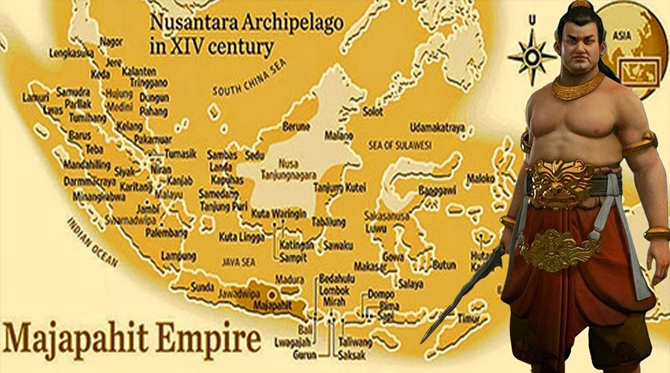
The rule of the Majapahit marks the strong influx of Javanese culture into Bali, most of all in architecture, dance and the theatre, in literature with the introduction of the Kawi script, in painting and sculpture and the wayang puppet theatre.
The few Balinese who did not adopt this culture are still known today as "Bali Aga" ("Original Balinese") and still live in a few isolated villages.
With the rise of Islam in the Indonesian archipelago, the Majapahit empire finally fell, and Bali became independent at the end of the 15th or beginning of the 16th century.
According to some myth the Javanese aristocracy fled to Bali, bringing an even stronger influx of Hindu arts, literature and religion.
According to later chronicles the dynasty of Majapahit origins, established after 1343, continued to rule Bali for 5 more centuries until 1908, when the Dutch eliminated it in the Dutch intervention in Bali (1908).
In the 16th century, the Balinese king Dalem Baturenggong even expanded in turn his rule to East Java, Lombok and western Sumbawa.
Around 1540, together with the Islamic advance, a Hindu reformation movement took place, led by Dang Hyang Nirartha, leading to the introduction of the Padmasana shrine in honour of the "Supreme God" Acintya, and the establishment of the present shape of Shiva-worshipping in Bali.
Nirartha also established numerous temples, including the spectacular temple at Uluwatu.
In ancient Bali, nine Hindu sects existed, namely Pasupata, Bhairawa, Siwa Shidanta, Waisnawa, Bodha, Brahma, Resi, Sora and Ganapatya. Each sect revered a specific deity as its personal Godhead.
Inscriptions from 896 and 911 do not mention a king, until 914, when Sri Kesarivarma is mentioned. They also reveal an independent Bali, with a distinct dialect, where Buddhism and Sivaism were practiced simultaneously.
Mpu Sindok's great-granddaughter, Mahendradatta (Gunapriyadharmapatni), married the Bali king Udayana Warmadewa (Dharmodayanavarmadeva) around 989, giving birth to Airlangga around 1001.
This marriage also brought more Hinduism and Javanese culture to Bali. Princess Sakalendukirana appeared in 1098. Suradhipa reigned from 1115 to 1119, and Jayasakti from 1146 until 1150.
Jayapangus appears on inscriptions between 1178 and 1181, while Adikuntiketana and his son Paramesvara in 1204.
Balinese culture was strongly influenced by Indian, Chinese, and particularly Hindu culture, beginning around the 1st century AD.
The name Bali dwipa ("Bali island") has been discovered from various inscriptions, including the Blanjong pillar inscription written by Sri Kesari Warmadewa in 914 AD and mentioning Walidwipa.
It was during this time that the people developed their complex irrigation system subak to grow rice in wet-field cultivation. Some religious and cultural traditions still practiced today can be traced to this period.
The Hindu Majapahit Empire (1293–1520 AD) on eastern Java founded a Balinese colony in 1343. The uncle of Hayam Wuruk is mentioned in the charters of 1384–86.
A mass Javanese immigration to Bali occurred in the next century when the Majapahit Empire fell in 1520.
Bali's government then became an independent collection of Hindu kingdoms which led to a Balinese national identity and major enhancements in culture, arts, and economy.
The nation with various kingdoms became independent for up to 386 years until 1906, when the Dutch subjugated and repulsed the natives for economic control and took it over.
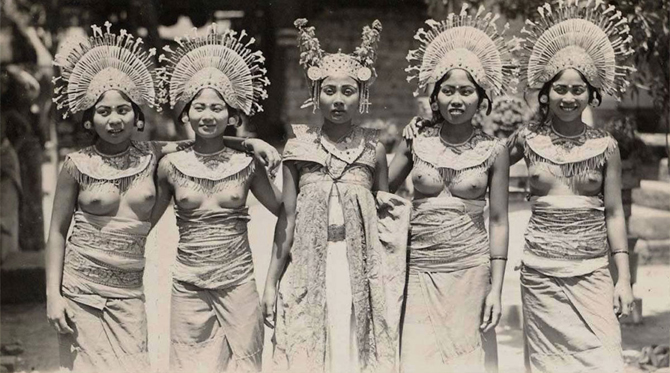
European contacts
The first direct or indirect news of Bali by some European travelers can be traced back to Marco Polo and other possible travelers and traders via the Mediterranean Sea and Asia.
The first known European contact with Bali is thought to have been made in 1512, when a Portuguese expedition led by Antonio Abreu and Francisco Serrão reached its northern coast.
It was the first expedition of a series of biannual fleets to the Moluccas, that throughout the 16th century usually traveled along the coasts of the Sunda Islands.
Bali was also mapped in 1512, in the chart of Francisco Rodrigues, aboard the expedition.
The Magellan expedition (1519–1522), through Elcano, is thought to have possibly sighted the island, and early Portuguese and Spanish charts mention the island under various names such as Boly, Bale and Bally.
Sir Francis Drake briefly visited the island in 1580. In 1585, the Portuguese government in Malacca sent a ship to establish a fort and a trading post in Bali, but the ship foundered on the reef of the Bukit peninsula and only five survivors could make it ashore.
They went into the service of the king of Gelgel, known as the Dalem, and were provided with wives and homes. In 1597, the Dutch explorer Cornelis de Houtman arrived in Bali with 89 surviving men (out of 249 who had departed).
After visits to Kuta and Jembrana, he assembled his fleet in Padang Bai. Enthusiastic, he christened the island "Young Holland" (Jonck Hollandt).
They were able to meet with the Dalem, who produced for them one of the Portuguese who had been in his service since 1585, Pedro de Noronha.
Bali Indonesian Independence
Imperial Japan occupied Bali during World War II with the declared objective of forming a "Greater East Asian Co-Prosperity Sphere" that would liberate Asian countries from Western domination.
The harshness of war requisitions made Japanese rule more resented than Dutch rule. Most of all, independence was strongly desired among the populace.
Following Japan's Pacific surrender in August 1945, the Balinese took over the Japanese weapons. The Dutch returned to Indonesia in 1946, including Bali, to reinstate their pre-war colonial administration.
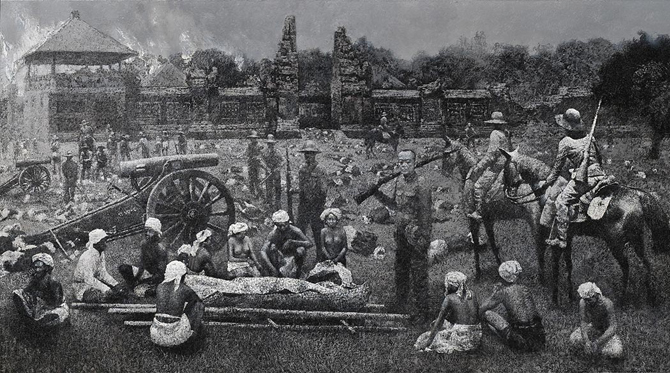
One Balinese, Colonel Gusti Ngurah Rai, formed a Balinese 'freedom army'. Colonel I Gusti Ngurah Rai, by then 29 years old, rallied his forces in east Bali at Marga Rana, where they were trapped by heavily armed Dutch troops.
On 20 November 1946, in the Battle of Marga, the Balinese battalion was entirely wiped out, breaking the last thread of Balinese military resistance.
In 1946 the Dutch constituted Bali as one of the 13 administrative districts of the newly proclaimed State of East Indonesia, a rival state to the Republic of Indonesia which was proclaimed and headed by Sukarno and Hatta.
Bali was included in the United States of Indonesia when the Netherlands recognised Indonesian independence on 29 December 1949.
The first governor of Bali, Anak Agung Bagus Suteja, was appointed by President Sukarno in 1958, when Bali became a province.
Bali Tourism
Every year millions of tourists come to Bali for leisure. The island even exceeded its target of attracting 3.1 million tourists by reaching 3.27 million a couple years ago.
But when exactly did Bali become ’noticed’ by tourists and travellers?
According to first data released by Official Netherlands Bureau there were 213 tourists visited Bali in 1924.
Koninklijke Paketcart Maatsckapy (KPM) or Royal Dutch Voyage Associate built Hotel Bali in Denpasar in 1928, where the Puputan Badung 1906 (Puputan Badung war of 1906) took place.

KPM started to provide weekly sailings to Bali since 1924 after previously built Bali’s transportation infrastructure in 1917.
The sailing routes were from Singapore, Batavia (Jakarta), Semarang, Surabaya, Buleleng (Singaraja Harbour), and Makassar - the route was known as Bali Express. This is considered as the starting point of tourists travelling to the island of Gods.
Two years later after 1924, magazine Tourism in Netherlands East Indies stated that on February 8th 1927, the number of travellers had increased into 480 people.
Seeing the significant increase of visitors to the island, KPM decided to build Hotel Bali to cater for the tourists.
Furthermore, the hotel also had an important role in Indonesian national history as it was where the Denpasar Conference was held in 1946, which resulted in the first recognition of east Indonesia.
In 1963 the Bali Beach Hotel in Sanur was built by Sukarno, and boosted tourism in Bali. Prior to it, only three hotels existed on the island.
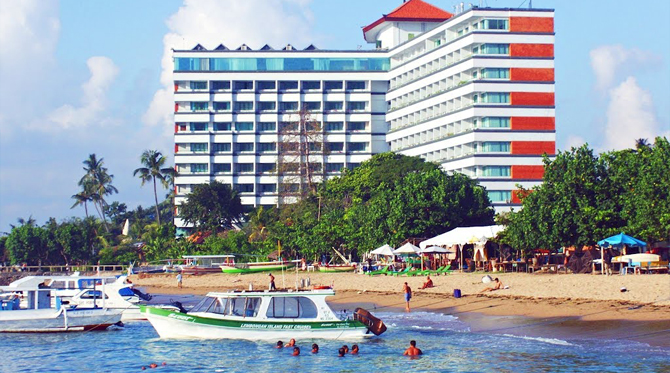
Construction of hotels and restaurants began to spread throughout Bali. Tourism further increased on Bali after the Ngurah Rai International Airport opened in 1970.
The Buleleng regency government encouraged the tourism sector as one of the mainstays for economic progress and social welfare.
The tourism industry is primarily focused in the south, while significant in the other parts of the island as well.
The main tourist locations are the town of Kuta (with its beach), and its outer suburbs of Legian and Seminyak (which were once independent townships), the east coast town of Sanur (once the only tourist hub).
Ubud towards the center of the island, to the south of the Ngurah Rai International Airport, Jimbaran, and the newer developments of Nusa Dua and Pecatu.
The United States government lifted its travel warnings in 2008. The Australian government issued an advisory on Friday, 4 May 2012, with the overall level of this advisory lowered to 'Exercise a high degree of caution'.
The Swedish government issued a new warning on Sunday, 10 June 2012 because of one tourist who died from methanol poisoning.
Australia last issued an advisory on Monday, 5 January 2015 due to new terrorist threats.
An offshoot of tourism is the growing real estate industry. Bali's real estate has been rapidly developing in the main tourist areas of Kuta, Legian, Seminyak and Oberoi.
Most recently, high-end 5-star projects are under development on the Bukit peninsula, on the south side of the island.

Million dollar villas are being developed along the cliff sides of south Bali, with commanding panoramic ocean views.
Foreign and domestic (many Jakarta individuals and companies are fairly active) investment into other areas of the island also continues to grow.
Land prices, despite the worldwide economic crisis, have remained stable. In the last half of 2008, Indonesia's currency had dropped approximately 30% against the US dollar, providing many overseas visitors value for their currencies.
Visitor arrivals for 2009 were forecast to drop 8% (which would be higher than 2007 levels), mainly due to the worldwide economic crisis which has also affected the global tourist industry.
Bali's tourism economy survived the Islamists terrorist bombings of 2002 and 2005, and the tourism industry has in fact slowly recovered and surpassed its pre-terrorist bombing levels; the longterm trend has been a steady increase of visitor arrivals.
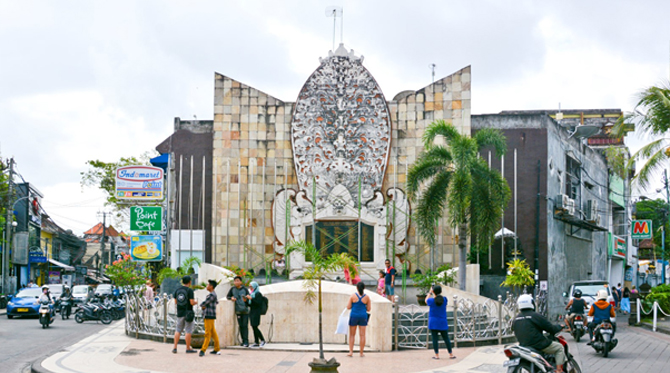
The 2002 Bali bombings occurred on 12 October 2002 in the tourist district of Kuta on the Indonesian island of Bali.
The attack killed 202 people (including 88 Australians, 38 Indonesians, and people of more than 20 other nationalities). A further 209 people were injured.
In 2010, Bali received 2.57 million foreign tourists, which surpassed the target of 2.0–2.3 million tourists.
The average occupancy of starred hotels achieved 65%, so the island still should be able to accommodate tourists for some years without any addition of new rooms/hotels, although at the peak season some of them are fully booked.
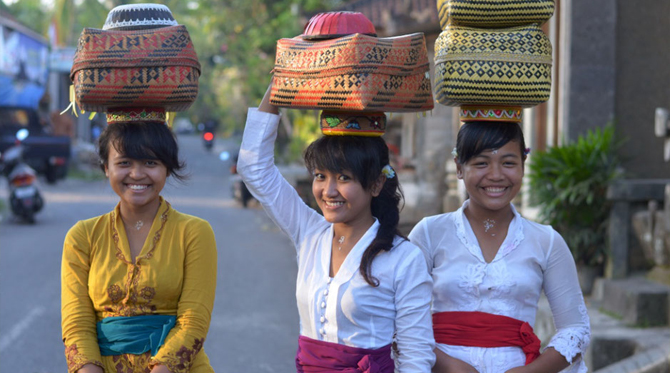
Bali received the Best Island award from Travel and Leisure in 2010. Bali won because of its attractive surroundings (both mountain and coastal areas), diverse tourist attractions, excellent international and local restaurants, and the friendliness of the local people.
The Balinese culture and its religion are also considered as the main factor of the award. One of the most prestigious events that symbolizes a strong relationship between a god and its followers is Kecak Dance.
According to BBC Travel released in 2011, Bali is one of the World's Best Islands, ranking second after Santorini, Greece.
In August 2010, the film Eat Pray Love was released in theatres. The movie was based on Elizabeth Gilbert's best-selling memoir Eat, Pray, Love.
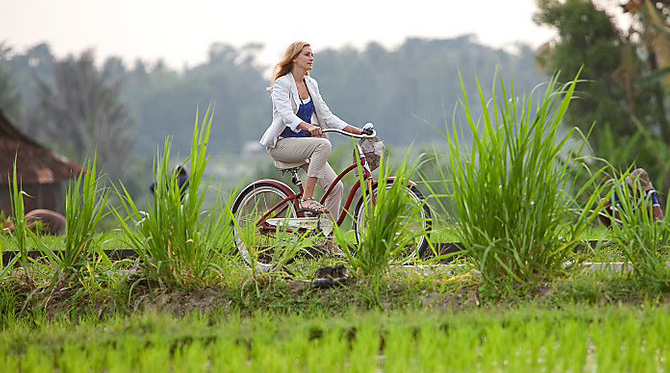
It took place at Ubud and Padang-Padang Beach at Bali. The 2006 book, which spent 57 weeks at the No. 1 spot on the New York Times paperback nonfiction best-seller list.
Had already fuelled a boom in Eat, Pray, Love-related tourism in Ubud, the hill town and cultural and tourist center that was the focus of Gilbert's quest for balance through traditional spirituality and healing that leads to love.
In January 2016, after music icon David Bowie died, it was revealed that in his will, Bowie asked for his ashes to be scattered in Bali, conforming to Buddhist rituals.
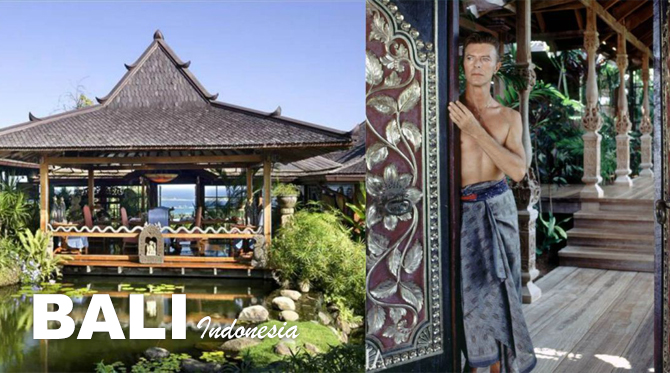
He had visited and performed in a number of Southeast Asian cities early in his career, including Bangkok and Singapore.
Since 2011, China has displaced Japan as the second-largest supplier of tourists to Bali, while Australia still tops the list.
Chinese tourists increased by 17% from last year due to the impact of ACFTA and new direct flights to Bali.
In January 2012, Chinese tourists year on year (yoy) increased by 222.18% compared to January 2011, while Japanese tourists declined by 23.54% yoy.
Bali reported that it welcomed 2.88 million foreign tourists and 5 million domestic tourists in 2012, marginally surpassing the expectations of 2.8 million foreign tourists.

Based on a Bank Indonesia survey in May 2013, 34.39 percent of tourists are upper-middle class, spending between $1,286 to $5,592, and are dominated by Australia, France, China, Germany and the US.
Some Chinese tourists have increased their levels of spending from previous years. 30.26 percent of tourists are middle class, spending between $662 to $1,285.
In 2017 it is expected that Chinese tourists will surpass Australian tourists as the most visited in Bali.
Bali Geography
Among 17,500 islands across the Indonesian archipelago, Bali is one of the 33 provinces of the Republic of Indonesia.
The largest archipelagic country in the world, made up of 2,000,000 km2 of land with a chain of islands stretching over 500,000 km from Sumatra to Papua, and covers territorial waters of more than 5,000,000 km2.
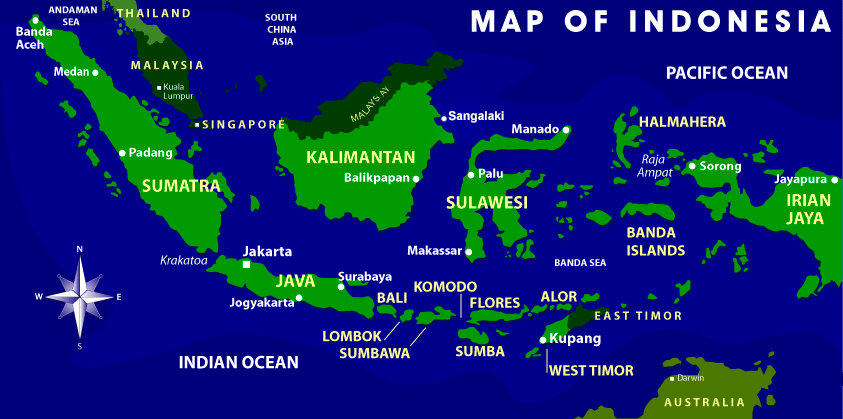
Situated between Java and Lombok, the island of Bali is located 8 to 9 degrees south of the equator with the Java Sea to the north, the Indian Ocean to the south.
Bali’s covers an area of 5,636 km2 or 0.29% of Indonesia, measuring just 90km long the north-south axis and less than about 140km from west to east.
Divided into three areas of water, the North Bali Sea is about 3,168km2, the East about 3.350km2, and the West about 2,982km2.
Bali Sea covers an area of 9,500km2. The North Bali sea runs along the coastline of Buleleng, the East Bali Sea runs along the coastline of Karangasem.

Klungkung and Gianyar, and the West Bali Sea include the coastline of Badung Tabanan and Jembrana.
The island of Bali lies 3.2 km (2.0 mi) east of Java, and is approximately 8 degrees south of the equator. Bali and Java are separated by the Bali Strait.
East to west, the island is approximately 153 km (95 mi) wide and spans approximately 112 km (70 mi) north to south; administratively it covers 5,780 km2 (2,230 sq mi).
Or 5,577 km2 (2,153 sq mi) without Nusa Penida District, its population density is roughly 750 people/km2 (1,900 people/sq mi).
Bali's central mountains include several peaks over 2,000 metres (6,600 feet) in elevation and active volcanoes such as Mount Batur.
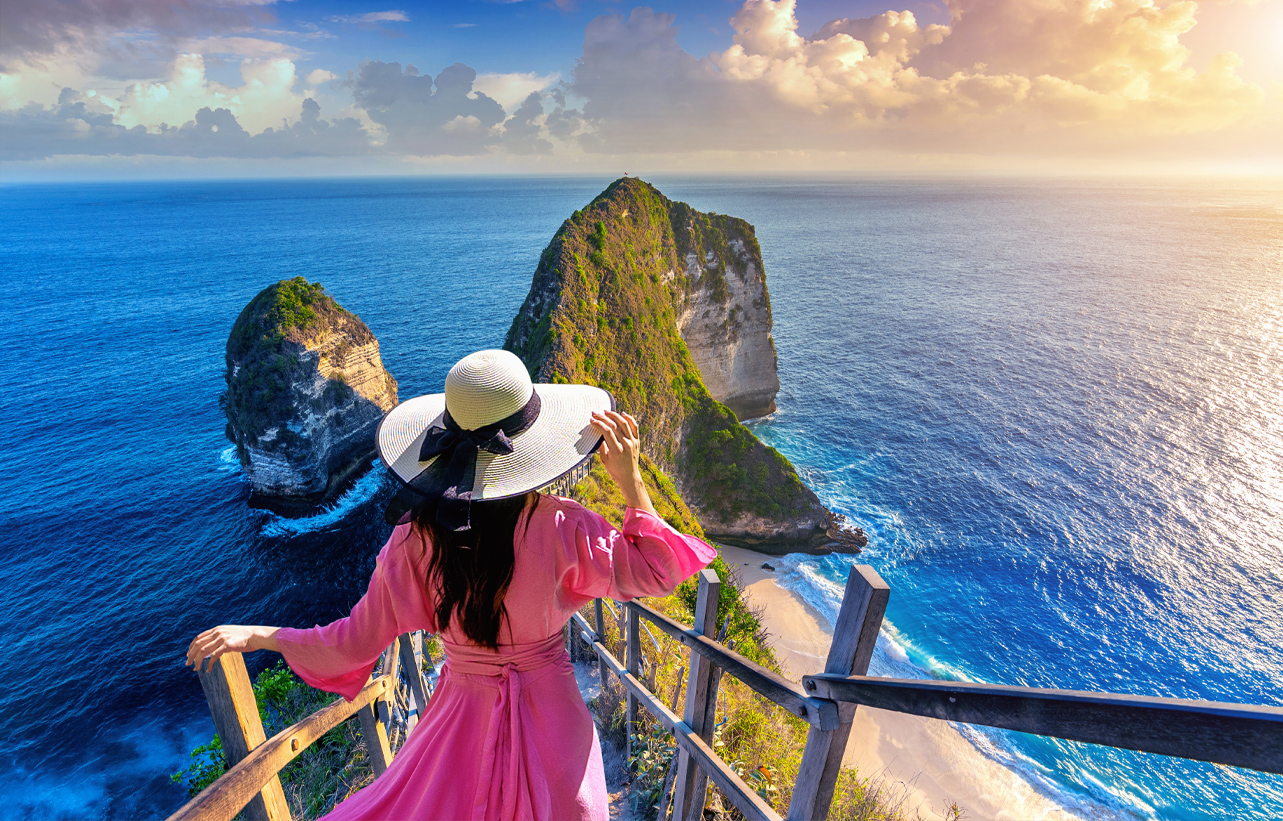
The highest is Mount Agung (3,031 m, 9,944 ft), known as the "mother mountain", which is an active volcano rated as one of the world's most likely sites for a massive eruption within the next 100 years.
As of late 2017 Mount Agung has started erupting and large numbers of people have been evacuated, the airport in Bali has been closed. The extent of the eruption is as of November 2017 impossible to predict.
Mountains range from centre to the eastern side, with Mount Agung the easternmost peak.
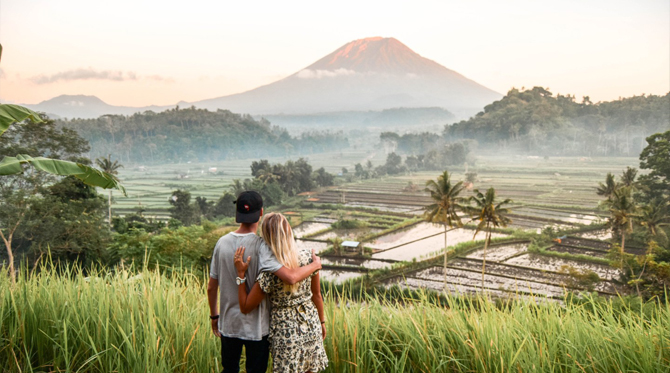
Bali's volcanic nature has contributed to its exceptional fertility and its tall mountain ranges provide the high rainfall that supports the highly productive agriculture sector.
South of the mountains is a broad, steadily descending area where most of Bali's large rice crop is grown.
The northern side of the mountains slopes more steeply to the sea and is the main coffee producing area of the island, along with rice, vegetables and cattle.
The island is surrounded by coral reefs. Beaches in the south tend to have white sand while those in the north and west have black sand.
Bali has no major waterways, although the Ho River is navigable by small sampan boats.
Black sand beaches between Pasut and Klatingdukuh are being developed for tourism, but apart from the seaside temple of Tanah Lot, they are not yet used for significant tourism.
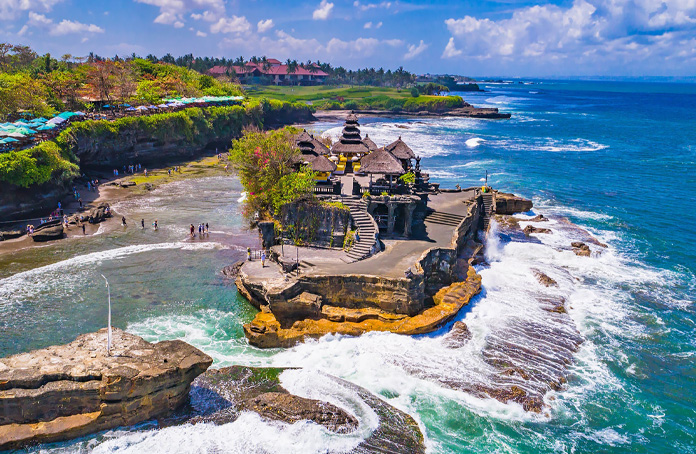
The largest city is the provincial capital, Denpasar, near the southern coast. Its population is around 491,500 (2002).
Bali's second-largest city is the old colonial capital, Singaraja, which is located on the north coast and is home to around 100,000 people.
Other important cities include the beach resort, Kuta, which is practically part of Denpasar's urban area, and Ubud, situated at the north of Denpasar, is the island's cultural centre.
Three small islands lie to the immediate south east and all are administratively part of the Klungkung regency of Bali: Nusa Penida, Nusa Lembongan and Nusa Ceningan. These islands are separated from Bali by the Badung Strait.
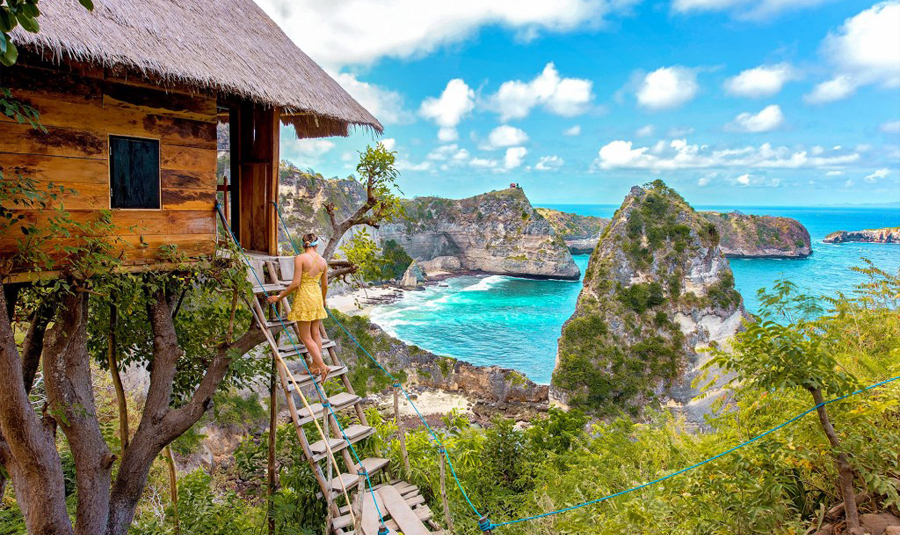
To the east, the Lombok Strait separates Bali from Lombok and marks the biogeographical division between the fauna of the Indomalayan ecozone and the distinctly different fauna of Australasia.
The transition is known as the Wallace Line, named after Alfred Russel Wallace, who first proposed a transition zone between these two major biomes.
When sea levels dropped during the Pleistocene ice age, Bali was connected to Java and Sumatra and to the mainland of Asia and shared the Asian fauna.
But the deep water of the Lombok Strait continued to keep Lombok Island and the Lesser Sunda archipelago isolated.
Bali Climate
Being just 8 degrees south of the equator, Bali has a fairly even climate all year round.
Average year-round temperature stands at around 30 °C (86 °F) with a humidity level of about 85%.
Day time temperatures at low elevations vary between 20 to 33 °C (68 to 91 °F), but the temperatures decrease significantly with increasing elevation.
The west monsoon is in place from approximately October to April, and this can bring significant rain, particularly from December to March.
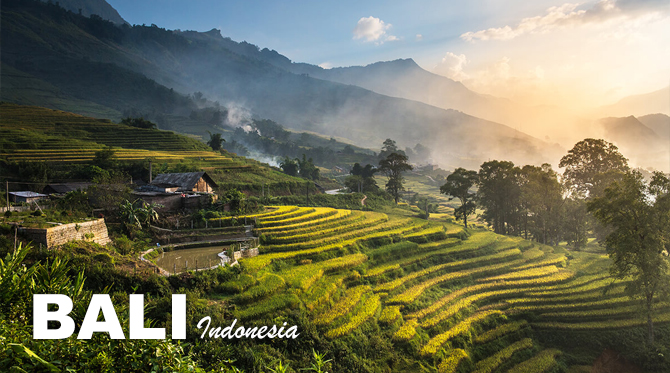
Rainy season starts from October to March, when the West monsoon brings heavy showers and high humidity.
June to September is considered the driest season, with low humidity and it can be fairly cold in the evenings, the best time for any outdoor activities.
Something unique can be found about climate in Bali. Even when it rains most times in the most parts of Bali you can often enjoy sunny days on the “Bukit”, the hill south of Jimbaran.
On the other hand, you may expect cloudy skies and drips throughout the year in Ubud and the mountainous areas.
Most interestingly perhaps, the international weather reports for “Denpasar” or “Bali” mention showers and rain storms all times of the year.
In higher regions such as in Bedugul or Kintamani you’ll expect to wear either a sweater or jacket when evening falls.
Bali Religion
Unlike most of Muslim-majority Indonesia, about 83.5% of Bali's population adheres to Balinese Hinduism, formed as a combination of existing local beliefs and Hindu influences from mainland Southeast Asia and South Asia.
Minority religions include Islam (13.37%), Christianity (2.47%), and Buddhism (0.5%).
The general beliefs and practices of Agama Hindu Dharma are a mixture of ancient traditions and contemporary pressures placed by Indonesian laws that permit only monotheist belief under the national ideology of Panca Sila.
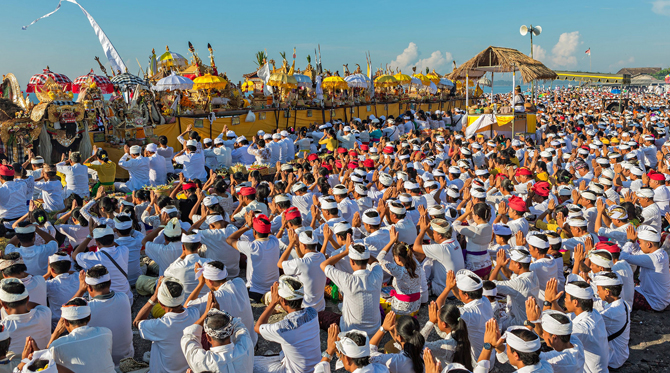
Traditionally, Hinduism in Indonesia had a pantheon of deities and that tradition of belief continues in practice; further, Hinduism in Indonesia granted freedom and flexibility to Hindus as to when, how and where to pray.
However, officially, Indonesian government considers and advertises Indonesian Hinduism as a monotheistic religion with certain officially recognised beliefs that comply with its national ideology.
Indonesian school text books describe Hinduism as having one supreme being, Hindus offering three daily mandatory prayers, and Hinduism as having certain common beliefs that in part parallel those of Islam.
Scholars contest whether these Indonesian government recognised and assigned beliefs reflect the traditional beliefs and practices of Hindus in Indonesia before Indonesia gained independence from Dutch colonial rule.
Balinese Hinduism has roots in Indian Hinduism and Buddhism, that arrived through Java. Hindu influences reached the Indonesian Archipelago as early as the first century.
Historical evidence is unclear about the diffusion process of cultural and spiritual ideas from India. Java legends refer to Saka-era, traced to 78 AD.
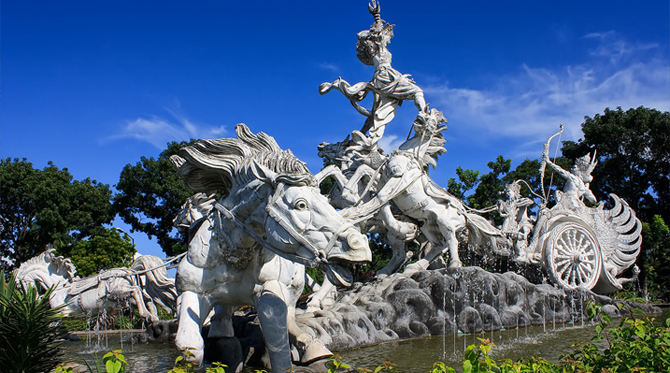
Stories from the Mahabharata Epic have been traced in Indonesian islands to the 1st century; however, the versions mirror those found in southeast Indian peninsular region (now Tamil Nadu and southern Karnataka Andhra Pradesh).
The Bali tradition adopted the pre-existing animistic traditions of the indigenous people. This influence strengthened the belief that the gods and goddesses are present in all things.
Every element of nature, therefore, possesses its own power, which reflects the power of the gods. A rock, tree, dagger, or woven cloth is a potential home for spirits whose energy can be directed for good or evil.
Balinese Hinduism is deeply interwoven with art and ritual. Ritualising states of self-control are a notable feature of religious expression among the people, who for this reason have become famous for their graceful and decorous behaviour.
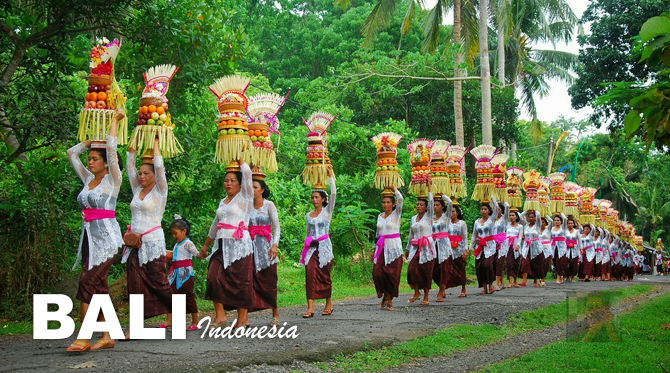
Apart from the majority of Balinese Hindus, there also exist Chinese immigrants whose traditions have melded with that of the locals.
As a result, these Sino-Balinese not only embrace their original religion, which is a mixture of Buddhism, Christianity, Taoism and Confucianism, but also find a way to harmonise it with the local traditions.
Hence, it is not uncommon to find local Sino-Balinese during the local temple's odalan. Moreover, Balinese Hindu priests are invited to perform rites alongside a Chinese priest in the event of the death of a Sino-Balinese.
Nevertheless, the Sino-Balinese claim to embrace Buddhism for administrative purposes, such as their Identity Cards.
Bali Language
Balinese language and Indonesian are the most widely spoken languages in Bali, and the vast majority of Balinese people are bilingual or trilingual.
The most common spoken language around the tourist areas is Indonesian, as many people in the tourist sector are not solely Balinese, but migrants from Java, Lombok, Sumatra, and other parts of Indonesia.
There are several indigenous Balinese languages, but most Balinese can also use the most widely spoken option: modern common Balinese.
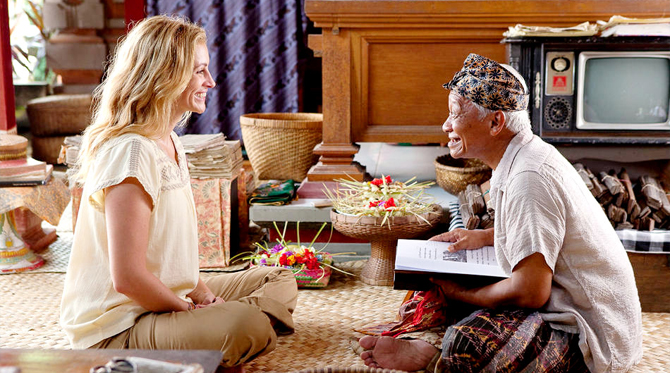
The usage of different Balinese languages was traditionally determined by the Balinese caste system and by clan membership, but this tradition is diminishing.
Kawi and Sanskrit are also commonly used by some Hindu priests in Bali, as Hindu literature was mostly written in Sanskrit.
English and Chinese are the next most common languages (and the primary foreign languages) of many Balinese, owing to the requirements of the tourism industry.
As well as the English-speaking community and huge Chinese-Indonesian population.
Other foreign languages, such as Japanese, Korean, French, Russian or German are often used in multilingual signs for foreign tourists.
So if you are a tourist and visitor traveling to Bali speaking some English you will be fine.
In all hotels and most restaurants you will have no problems with English. And as you can see on the picture, the Balinese might translate "creatively", but you will still understand what they mean.
International chain hotels also often employ staff who speak the languages of countries, where most of their guests originate from.
Bali Culture
Balinese culture is a mix of Balinese Hindu-Buddhist religion and Balinese customs. It is perhaps most known for its dance, drama and sculpture.
Balinese cuisine is also distinctive. Balinese percussion orchestra music, known as gamelan, is highly developed and varied.
Balinese performing arts often portray stories from Hindu epics such as the Ramayana but with heavy Balinese influence.
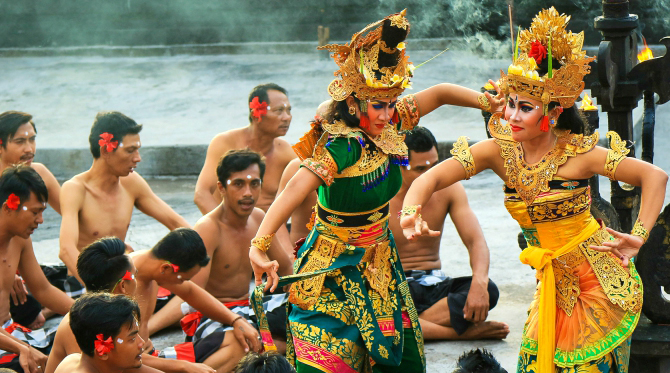
Famous Balinese dances include pendet, legong, baris, topeng, barong, gong keybar, and kecak (the monkey dance).
Bali boasts one of the most diverse and innovative performing arts cultures in the world, with paid performances at thousands of temple festivals, private ceremonies, or public shows.
According to Mexican art historian José Miguel Covarrubias, works of art made by amateur Balinese artists are regarded as a form of spiritual offering, and therefore these artists do not care about recognition of their works.
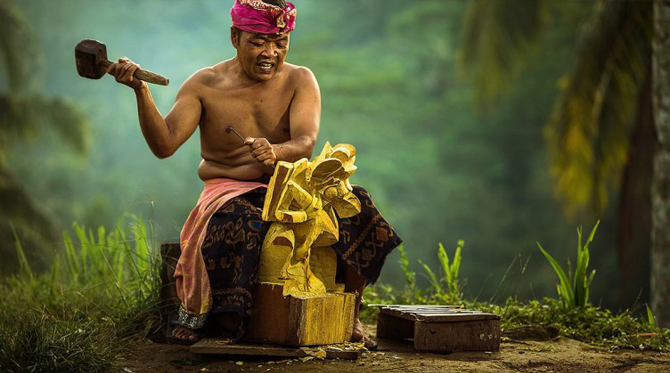
Balinese artists are also skilled in duplicating art works such as carvings that resemble Chinese deities or decorating vehicles based on what is seen in foreign magazines.
The culture is noted for its use of the gamelan in music and in various traditional events of Balinese society. Each type of music is designated for a specific type of event.
For example, music for a piodalan (birthday celebration) is different from music used for a metatah (teeth grinding) ceremony, just as it is for weddings, Ngaben (cremation of the dead ceremony), Melasti (purification ritual) and so forth.
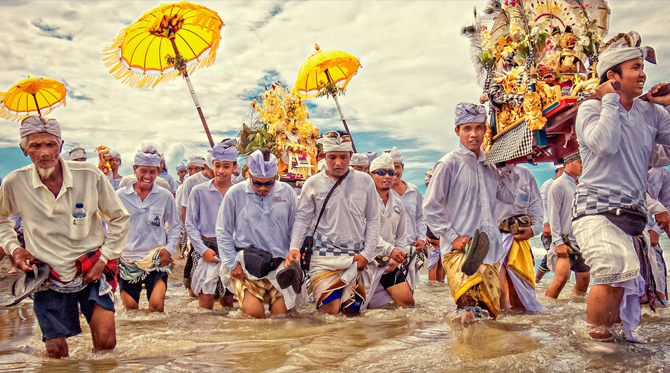 >
>
The diverse types of gamelan are also specified according to the different types of dance in Bali.
According to Walter Spies, the art of dancing is an integral part of Balinese life as well as an endless critical element in a series of ceremonies or for personal interests.
Traditionally, displaying of female breasts is not regarded as immodest. Balinese women can often be seen with bared chests; however, a display of the thigh is considered immodest.
In modern Bali these customs are normally not strictly observed, but visitors visiting Balinese temples are advised to cover their legs.
Bali Life Style
Bali’s population of over 3,000,000 souls spread over the whole island, including those in the smaller islands of Nusa Penida, Nusa Ceningan, Nusa Lembongan, Serangan and Menjangan Island.
The overwhelming majority of Balinese are Hindus, with the increasing number on non-Hindu migrating from the closest neighboring islands of Java and Lombok.
The coastal areas in the south are the most populous area with over 370,000 people living in various professions in the capital of Denpasar.
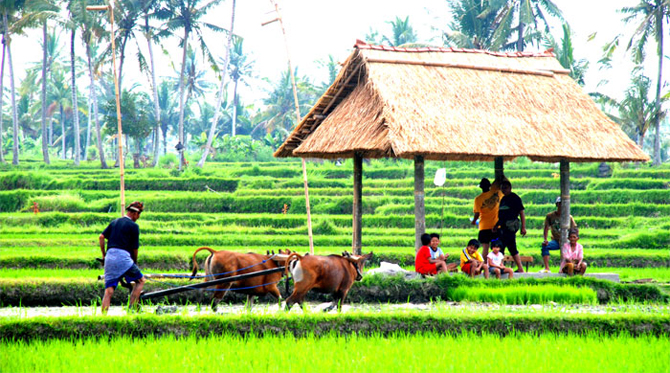
Farming has been the primary way of living in Balinese life. Where else fishing, trading and craftsmanship are also in fashion from generation to generation.
Yet with the fast growing of tourism since past few decades, young people start to build up a new touch in their living culture.
Life Style in Bali is very communal under the organization of villages. Temple ceremonies, marriage, cremation, farming and even the creative art festivals are decided by the local community institution called “Banjar”.
The responsibilities in the day-to-day life are normally administered by both the Banjar and the government.
The local government mostly responsible for schools, health clinics, hospitals and roads, and Banjar is responsible for all other aspects of life.
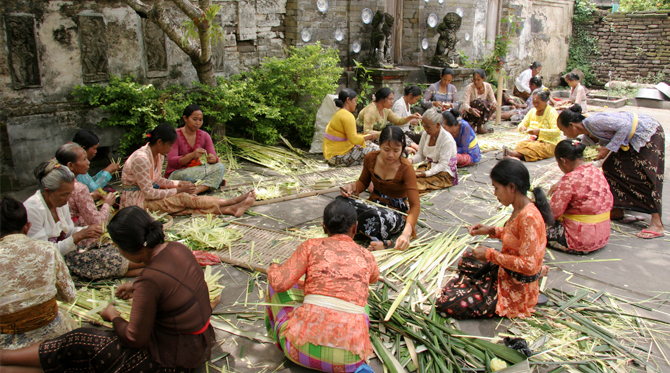
There is another association exists in the banjar named “Subak” that concerns to the production of rice and organizes the complex irrigation system.
Every family who owns a rice field must be a member of their local Subak, which then ensures that every member gets his fair distribution of water.
A banjar consists of an average of 50 to 150 family members, owning a meeting venue called the Bale Banjar, which is used for regular gatherings and a center for local gamelan orchestras and drama groups.
Bali Festival & Events
Throughout the year, there are a number of festivals celebrated locally or island-wide according to the traditional calendars.
The Hindu New Year, Nyepi, is celebrated in the spring by a day of silence. On this day everyone stays at home and tourists are encouraged (or required) to remain in their hotels.
On the day before New Year, large and colourful sculptures of ogoh-ogoh monsters are paraded and finally burned in the evening to drive away evil spirits. Other festivals throughout the year are specified by the Balinese pawukon calendrical system.
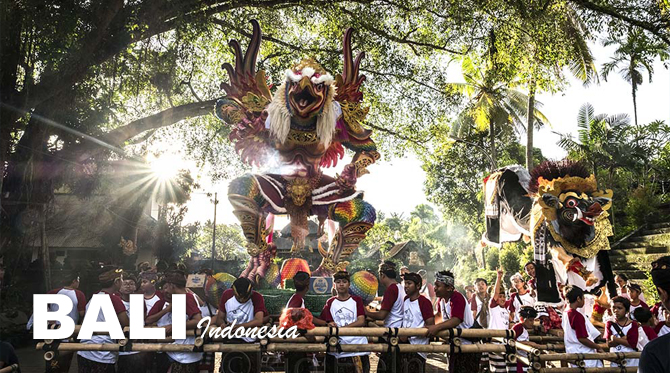
Celebrations are held for many occasions such as a tooth-filing (coming-of-age ritual), cremation or odalan (temple festival).
One of the most important concepts that Balinese ceremonies have in common is that of désa kala patra, which refers to how ritual performances must be appropriate in both the specific and general social context.
Many of the ceremonial art forms such as wayang kulit and topeng are highly improvisatory, providing flexibility for the performer to adapt the performance to the current situation.
Many celebrations call for a loud, boisterous atmosphere with lots of activity and the resulting aesthetic, ramé, is distinctively Balinese.
Often two or more gamelan ensembles will be performing well within earshot, and sometimes compete with each other to be heard.
Likewise, the audience members talk amongst themselves, get up and walk around, or even cheer on the performance.
Tourism, Bali's chief industry, has provided the island with a foreign audience that is eager to pay for entertainment, thus creating new performance opportunities and more demand for performers.
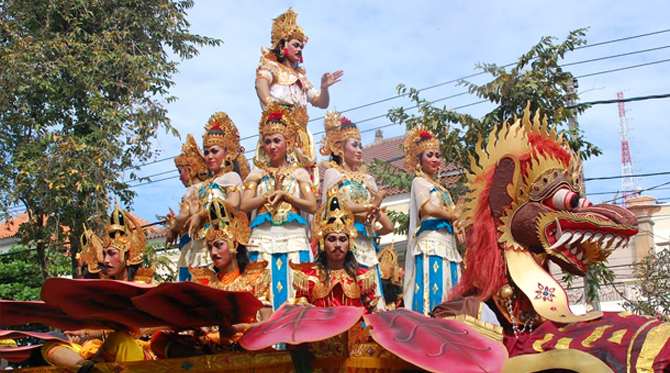
The impact of tourism is controversial since before it became integrated into the economy, the Balinese performing arts did not exist as a capitalist venture, and were not performed for entertainment outside of their respective ritual context.
Since the 1930s sacred rituals such as the barong dance have been performed both in their original contexts, as well as exclusively for paying tourists.
This has led to new versions of many of these performances which have developed according to the preferences of foreign audiences; some villages have a barong mask specifically for non-ritual performances as well as an older mask which is only used for sacred performances.
Bali festivals and events are important features in the social landscape of the island, and also permanent fixtures in the lives of the Balinese.
Some of these unique cultural festivals and events are determined by Balinese calendars from long ago, while others are highlighted schedules that take place on certain dates each year.
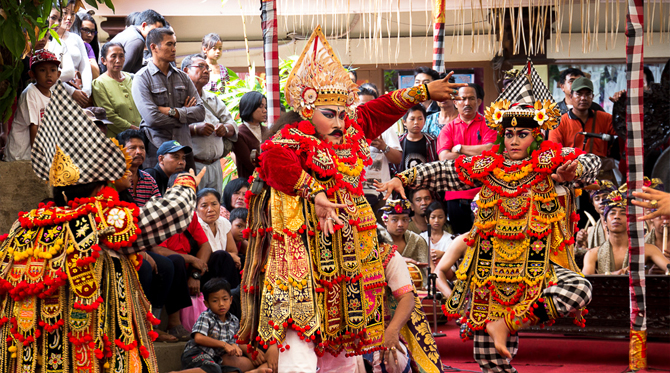
These festivals largely form part of Bali's attractions and culture, showcasing the rich arts and cultural features that sets Bali apart from any other destination.
The Provincial Government of Bali holds numerous festivals that pay tribute to this wealth, and the great thing is that you can match your visiting dates with these highlight events.
Below are the list of several popular festival & events in Bali;
1. Bali Arts Festival - The annual Bali Arts Festival is held from the second Saturday of June through the second Saturday of July each year.
Witness the grand parades that usually take place at the Puputan Square in Renon, Denpasar, and the schedule of art performances that run througout the weeks at the Denpasar Arts Centre.
2. Bali Kites Festival - The Bali Kite Festival is an annual celebration of one of the cultural icons of Bali, the traditional Balinese kite. It is an annual feast that serves as a preservation effort of an art form.
Anticipated by the international community, and involving village kite troupes from al over the island taking part in showcasing their gigantic traditional creations as well as contemporary designs.
The festival usually takes place around the start of the windy season, between the months of June and August, with dates confirmed following favourable weather conditions.
3. Galungan and Kuningan - Bali's most important festival is the Galungan festival. It is a feast and festival which is held throughout the whole island and an annual event coinciding with the wuku year.
It is believed that during this ten-day period, all Balinese gods will descend to earth for the festivities. Barongs prance from temple to temple and village to village in celebration of Galungan with the gods.
Galungan to the Balinese, is the most important holiday period as it symbolises the victory of Dharma, or Virtue, upon Adharma, or all that is Evil. The festivities are made extra special by the fitting of 'penjor' on the right side of the entrance to every house.
A penjor is a tall bamboo pole terrifically decorated with woven young coconut leaves, cakes, fruits and flowers; and also a must for every Balinese household.
The Galungan also sees the Balinese decked in their finest clothes and jewels for the day. The last day of the 10-day festival is the most important day.
Known as Kuningan, it is the climax of the ten-day Galungan, and also serves to bringing the holiday period to a close.
Kuningan is a day for prayer, and a special ritual ceremony is held for the spirits of the Balinese's ancestors.
Just as the Galugan ends with a day of symbolic prayer, its beginning is marked by Pagerwesi.
Pagerwesi literally means 'iron fence', and on Pagerwesi day every year, ceremonies and prayers are held in supplication for iron-strong mental and spiritual defense in welcoming the Galungan holiday.
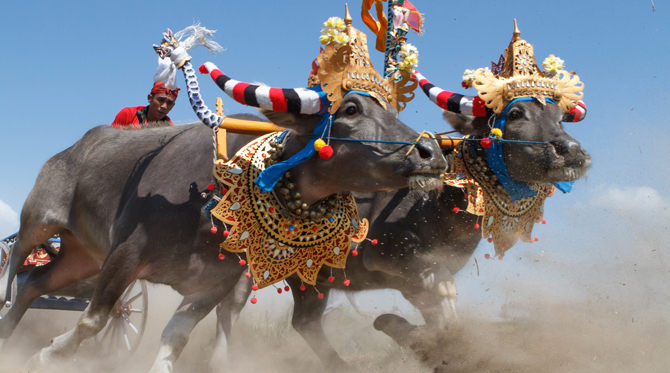
4. Makepung Buffalo Races - Makepung is Bali's famous bull race, which takes place around harvested paddy fields around the town of Jembrana in the regency of Negara in West Bali.
The official grand prix of buffaloes is designated as the Governor's Cup or 'Piala Bupati', which is scheduled every year around the month of July, and leads up to the finals and main celebrations around the month of November.
5. Nyepi - Bali celebrates a new year celebrating the turn of the Saka calendar, referred to as Nyepi.
Nyepi falls on the day after the new moon on the ninth month, and is a new year that is celebrated uniquely - in total silence and seclusion!
On the day of Nyepi, there no activity whatsoever. No traffic at all on the roads; no amusement is held the whole day long, and no fires may be lit in observance of the religious Nyepi guidelines.
On Nyepi Eve however, it is a whole scene of contrasts, as you may witness villagers all over the island lighting fire torches and parading giant effigies called ogoh-ogoh through the streets.
6. Sanur Village Festival - The Sanur Village Festival is an annual celebration of arts and culture of the Sanur beach community, featuring a week full of cultural highlights as well as food, water sports and environmental-awareness events.
The week-long festivities are usually focused in the Maisonette area of the Inna Grand Bali Beach Hotel.
Over the years, the festival features additional events that involve the fashion industry, yoga and wellbeing, sports and environmental awareness programs.
7. Saraswati - Saraswati is a holiday that celebrates the blessings of the namesake Hindu goddess of knowledge, arts and literature, often referred to by the Balinese as 'Dewi Saraswati'.
To mark this joyous day, books of knowledge, manuscripts and Vedic scriptures are blessed and special offerings are made. Libraries and schools also conduct joint prayers.
The day of Saraswati is the first in a series of five important religious highlights, and falls on an Umanis Watugunung Saturday on the Balinese 210-day pawukon calendar, hence its celebrations twice in a Gregorian year.
8. Chinese New Year - Chinese New Year in Bali takes place around late January or mid-February each year.
This special holiday is observed by Balinese of Chinese descent as well as by most Chinese Indonesians across the nation. Bali’s Chinese cultural influences go way back throughout the island’s history.
Examples include Balinese temples bearing Chinese architectural features, the use of ancient Chinese coins in rituals, and early settlements in the Kintamani highlands where legend tells of the marriage between a Balinese king and a Chinese princess.
Fast forward to present day, you can visit majestic Chinese and Buddhist temples, called klenteng in the local tongue, around the island.
They’re great places to visit on any day of the year, but are truly alive and festive during the Chinese New Year celebrations.
Chinese barongsai lion and dragon dance troupes, together with their drum and cymbal wielding entourage, carry out wushu performances and acrobatic stunts to cheering crowds on the street and within temple courtyards.
Bali Transportation
As one of the world’s go-to vacation destinations, Bali is a paradise to be experienced.
As an Indonesian island known for its forested volcanic mountains, iconic rice paddies, beaches and coral reefs, it is a destination loved by all.
Make sure you experience the best Bali has to offer and be sure to know exactly how to make your way around this picturesque island.
From taxis to private cars to motorcycles, we have tracked down the most convenient and easiest ways to travel around the island, so you don’t have to.
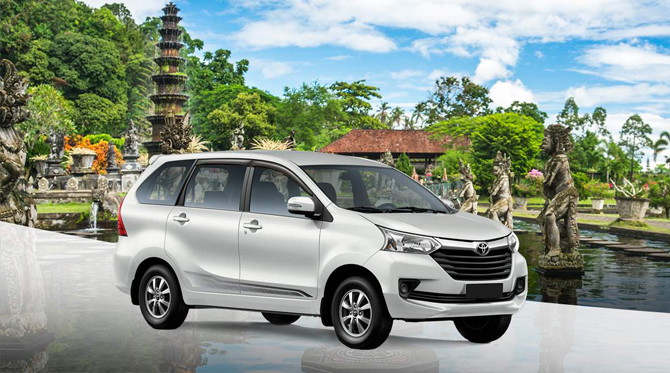
Bali is a fairly big island, and if you’re planning to travel between popular cities, such as Ubud, Kata, Legian or Seminyak, you will need to rely on some form of transportation.
Shuttle buses are budget friendly and travel between the major cities, but they are slow and stop frequently. Organized tours are a more popular option for visiting attractions.
If you’d prefer a more flexible form of transportation, metered taxis are available in and to major cities.
A rental car is also an option, but hiring a private driver is more common and preferable if you’re unfamiliar with Balinese road rules.
Below are the list of the most popular taranspotation in Bali
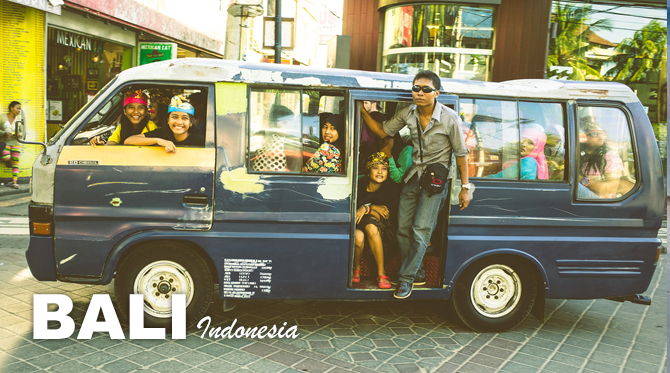
Bemo : this is the most used transportation in Bali especially in the city of Denpasar. It is a miniature van with a routine route set by local government periodically.
This type of transportation is good for short distance around town and cities, because of its size and passenger can get in and out at any point.
They are usually employed on tours between city and suburbs and can seat up to 10 passengers per vehicle, sometimes even more than its capacity.
Most importantly, it is cheaper compared to some other type of transportations, even though fairly slow.
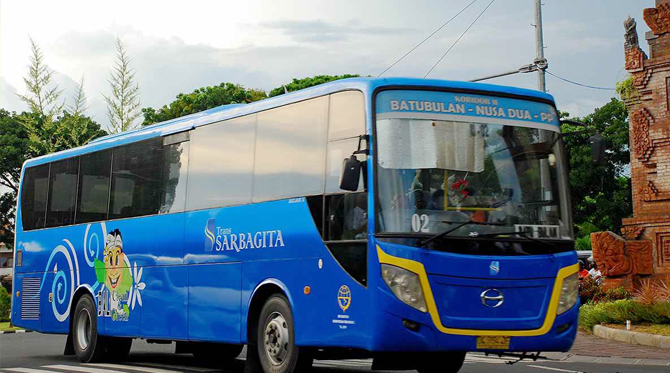
Buses : there are buses for transportation between towns that relatively bigger compared to bemo. These buses connect all towns and most places of the island through local bus stations.
Likewise bemo, buses also can be stopped at any point of the routes. They mostly operate day time inter island, but some are available at night for long distances within cities.
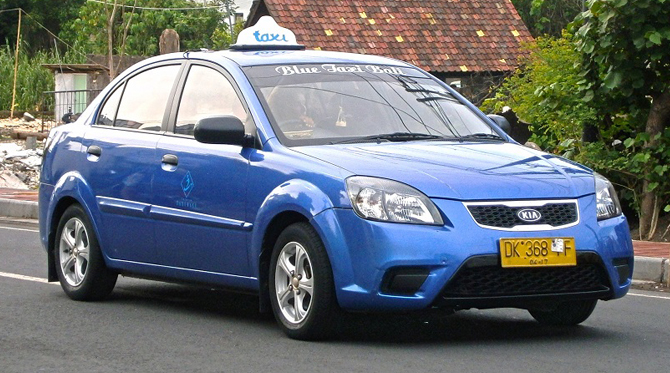
Taxi : Taxi is the most efficient and convenience transportation in the island. Either chartered or metered one, they are everywhere and quite inexpensive compared to some other countries.
Ojek : A motorcycle taxi, or cart bike, is a licensed form of transport in some countries. The taxi typically carries one passenger, who rides as the pillion behind the motorcycle operator.
Ferry and speed boat : Travel between Bali, Lombok, the Gili Islands and Lembongan is available through Bali Ferry with frequent departures during the day.
Getting Around Bali
The best way to get around Bali is with a hired car and driver. This option gives you the freedom of roaming around the country without the hassle of having to drive yourself.
Travel by private air-conditioned car and be assisted by an English-speaking driver. Make your Bali vacation even more blissful by exploring the island of Bali on your own terms.

Your trip starts where you wish, get picked up from your hotel or a place of your choosing and then set off to explore the area.
Biking is another option, just be prepared to weave through chaotic traffic. Boats are a great way to get to neighbouring islands, but they are not frequently used to get around Bali.
Most travellers arrive through Ngurah Rai International Airport (DPS), which is located between Kuta and Jimbaran on the island's southern tip.
To reach your hotel, check in advance to see if there is a complimentary resort shuttle available. Some hotels also provide private transportation for a fee.
Though it can be pricey, some visitors say it's worth the cost (especially if you're arriving at night) as the driver will know exactly where to drop you off – a convenience some say is worth the extra rupiahs.

Driving a scooter or motorbike the best way to get around if you are not going for long trips.
If you want to go to the beach, do some shopping, visit some restaurants etc then a scooter does really make things very easy and convenient.
However, safety is indeed an issue. As described above already the traffic itself is a challenge but other factors create additional risks.
If you plan to take a taxi, you'll prepay your fare at the airport's taxi counter. Fares range widely depending on your destination, from 45,000 IDR to 315,000 IDR.
The next option is by Buses there are buses for transportation between towns that relatively bigger compared to bemo.
These buses connect all towns and most places of the island through local bus stations. Likewise bemo, buses also can be stopped at any point of the routes.
They mostly operate day time inter island, but some are available at night for long distances within cities. Fares are between 1.500 IDR to Rp. 10.000 IDR per one stop point.
What to Expect from Bali
Whatever your expectations and desires, they all can be more than fulfilled. Bali is regularly rated one of the Top 10 tropical holiday destinations of the world.
However, Bali is not straight forward. It is diverse, complex and sometimes unpredictable and fall short on your expectations if you don't know some basic rules.

The island is a vibrant, dynamic organism which is home to 4mio Indonesians and a few thousand expats living and making a living here.
Bali is a "real place", with real people. Although one can find the most luxurious resorts, pristine beaches, best cuisines, and coconut trees on Bali.
It is not like the Maldives or Bahamas, where everything is streamlined to the standards of global tourism and where Tourism Managers have invented concepts to provide "predictable surprises" for tourists.
Bali Ecology
Bali lies just to the west of the Wallace Line, and thus has a fauna that is Asian in character, with very little Australasian influence, and has more in common with Java than with Lombok.
An exception is the yellow-crested cockatoo, a member of a primarily Australasian family. There are around 280 species of birds, including the critically endangered Bali myna, which is endemic.
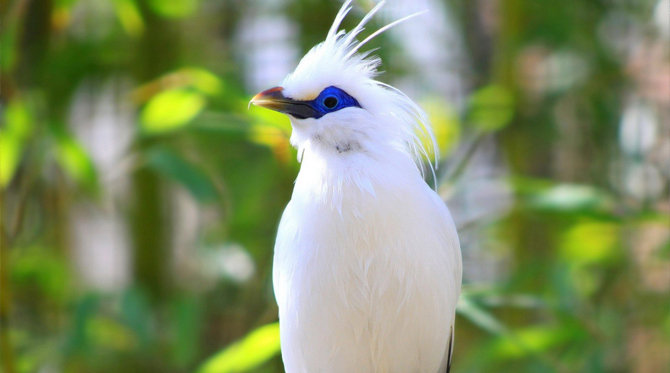
Others include barn swallow, black-napped oriole, black racket-tailed tree pie, crested serpent-eagle, crested tree swift, dollar bird, Java sparrow, lesser adjutant, long-tailed shrike, and milky stork.
Including Pacific swallow, red-rumpled swallow, sacred kingfisher, sea eagle, wood swallow, savanna nightjar, stork-billed kingfisher, yellow-vented bulbul and great egret.
Until the early 20th century, Bali was home to several large mammals: the wild banteng, leopard and the endemic Bali tiger.
The banteng still occurs in its domestic form, whereas leopards are found only in neighbouring Java, and the Bali tiger is extinct.
The last definite record of a tiger on Bali dates from 1937, when one was shot, though the subspecies may have survived until the 1940s or 1950s.
Squirrels are quite commonly encountered, less often is the Asian palm civet, which is also kept in coffee farms to produce Kopi Luwak.
Bats are well represented, perhaps the most famous place to encounter them remaining is the Goa Lawah (Temple of the Bats) where they are worshipped by the locals and also constitute a tourist attraction.
They also occur in other cave temples, for instance at Gangga Beach. Two species of monkey occur. The crab-eating macaque, known locally as "kera", is quite common around human settlements and temples.
Where it becomes accustomed to being fed by humans, particularly in any of the three "monkey forest" temples, such as the popular one in the Ubud area.

They are also quite often kept as pets by locals. The second monkey, endemic to Java and some surrounding islands such as Bali, is far rarer and more elusive and is the Javan langur, locally known as "lutung".
They occur in few places apart from the Bali Barat National Park. They are born an orange colour, though by their first year they would have already changed to a more blackish colouration.
In Java however, there is more of a tendency for this species to retain its juvenile orange colour into adulthood, and a mixture of black and orange monkeys can be seen together as a family.
Other rarer mammals include the leopard cat, Sunda pangolin and black giant squirrel.
Snakes include the king cobra and reticulated python. The water monitor can grow to at least 1.5 m (4.9 ft) in length and 50 kg (110 lb)and can move quickly.
The rich coral reefs around the coast, particularly around popular diving spots such as Tulamben, Amed, Menjangan or neighbouring Nusa Penida, host a wide range of marine life.
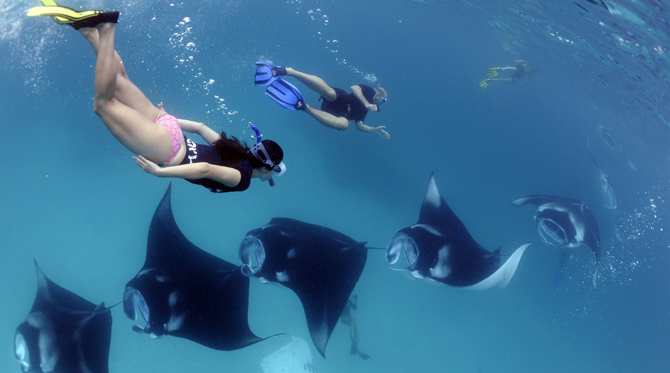
For instance hawksbill turtle, giant sunfish, giant manta ray, giant moray eel, bumphead parrotfish, hammerhead shark, reef shark, barracuda, and sea snakes.
Dolphins are commonly encountered on the north coast near Singaraja and Lovina.
A team of scientists conducted a survey from 29 April 2011 to 11 May 2011 at 33 sea sites around Bali.
They discovered 952 species of reef fish of which 8 were new discoveries at Pemuteran, Gilimanuk, Nusa Dua, Tulamben and Candidasa, and 393 coral species, including two new ones at Padangbai and between Padangbai and Amed.
The average coverage level of healthy coral was 36% (better than in Raja Ampat and Halmahera by 29% or in Fakfak and Kaimana by 25%) with the highest coverage found in Gili Selang and Gili Mimpang in Candidasa, Karangasem regency.
Among the larger trees the most common are: banyan trees, jackfruit, coconuts, bamboo species, acacia trees and also endless rows of coconuts and banana species.
Numerous flowers can be seen: hibiscus, frangipani, bougainvillea, poinsettia, oleander, jasmine, water lily, lotus, roses, begonias, orchids and hydrangeas exist.
On higher grounds that receive more moisture, for instance around Kintamani, certain species of fern trees, mushrooms and even pine trees thrive well. Rice comes in many varieties.
Other plants with agricultural value include: salak, mangosteen, corn, kintamani orange, coffee and water spinach.
Bali Agriculture
Although tourism produces the GDP's largest output, agriculture is still the island's biggest employer. Fishing also provides a significant number of jobs.
Bali is also famous for its artisans who produce a vast array of handicrafts, including batik and ikat cloth and clothing, wooden carvings, stone carvings, painted art and silverware.

Notably, individual villages typically adopt a single product, such as wind chimes or wooden furniture.
The Arabica coffee production region is the highland region of Kintamani near Mount Batur. Generally, Balinese coffee is processed using the wet method.
This results in a sweet, soft coffee with good consistency. Typical flavours include lemon and other citrus notes.
Many coffee farmers in Kintamani are members of a traditional farming system called Subak Abian, which is based on the Hindu philosophy of "Tri Hita Karana".
According to this philosophy, the three causes of happiness are good relations with God, other people, and the environment.
The Subak Abian system is ideally suited to the production of fair trade and organic coffee production.
Arabica coffee from Kintamani is the first product in Indonesia to request a geographical indication.
Useful Tips For Your First Time In Bali
The magical island of Bali has so much to offer, from rice fields, to volcanoes, to waterfalls, to beautiful beaches, to temples, and amazing restaurants and bars.
Traveling to Bali for the first time, requires some proper planning, tips and tricks to make your Bali holiday a safe, secure and fun experience.
Here is a useful list of things you should know before you go compiled by several travellers who wished they had it on their first trip.
From how to say thank you in Indonesian, what sort of electrical adaptor you'll need, to packing extra sunscreen (it can be quite $$$), and much more.
1. So the fist tip that we have is get your head around the current visa situation - In early 2016, Indonesia waived its standard 30-day tourist visa-on-arrival (VOA) system for 169 countries; visitors from most other nations (including Australians) must purchase the VOA.
While extending a 30-day visa is possible, it can be a tricky business. Speak to a reputable visa agent on the ground, or contact your nearest Indonesian consulate prior to departure.
At the time of publication, 60-day visas could be arranged in advance, but not in-country. Know more about Visa on Arrival (VoA).
2. Respect religious customs - Religion rules the roost in Bali. Don’t get your knickers in a knot when a street is blocked off for a ceremony or your driver pulls over mid-trip to make a blessing – this is all part of the magic of the island.
Plan accordingly if your travel dates fall on Nyepi when everything in Bali (even the airport) shuts down for the day, and always dress modestly (covering the shoulders and knees) and conduct yourself appropriately when visiting temples and holy sites.
3. Play by the rules - The Indonesian legal system may seem confusing and contradictory, but it's best not argue with police if you are accused of an infringement that may feel unjust, and pay ‘fines’ with good grace.
Do not expect any special treatment for being a foreigner, and it goes without saying that having anything to do with drugs is a very bad idea.
4. Respect the ocean - Even if you’re an avid beach-goer and surf worshipper, Bali's powerful waves, strong currents and exposed rocks can be treacherous, so take care, and don't swim alone unless you are completely confident in doing so.
Show equal respect for the beach by not leaving any garbage (including cigarette butts) behind – when the tide comes in, it'll be sucked into the ocean at great cost to the marine ecosystem.
5. Be Aware of Added Tax in Bar or Restaurant - By law, all bars and restaurants must charge an additional 21% on their food and drink prices.
Whilst some add this in to the menu price, others will include small print stating it will be added to the bill.
This is completely legit, however, it's definitely something to be aware of as will add a hearty chunk on to your bill at the end of the meal!.
6. Dress for the occasion - Beachwear doesn’t always cut it in Bali – many higher-end bars, restaurants and clubs enforce a dress code.
If you’re unsure, call ahead to save the potential embarrassment of being turned away.
7. Currency & how to avoid money exchange scams in Bali - The main currency in Bali is Indonesian Rupees (IDR) and it’s best to always have cash with you because lots of places don’t accept credit cards (mainly in the markets).
Make sure to exchange your money only in “authorized” money exchanges that have cameras installed inside, because there are loads of unauthorized places that can scam you right in from of your eyes.
The exchanges all look similar, but authorized ones have cameras and will always give you a receipt. Another option is to use one of the many ATM machines available in all the main areas on the island.
8. On temple visits - cover up, if you don’t already have a sarong to cover your legs, there is often somewhere you can borrow or hire one from.
Also make sure your shoulders are covered too, wearing a sleeved t-shirt is often the best option.
9. Charging your devices - 220 Volts, 50Hz. Electrical plugs are two-pronged ‘Europlug’ type.
10. Get an international driver's license - If you intend to hire a car in Bali, this is a must. Always carry your insurance and registration papers with you for the hired car, when driving.
11. Get an international driver's license - If you intend to hire a car in Bali, this is a must. Always carry your insurance and registration papers with you for the hired car, when driving.
Bali Airport
Bali airport (Ngurah Rai International Airport also known as Denpasar International Airport) is your main entry point to the island.
The airport is in Tuban, an approximate 15 minute drive south of Kuta. Its runway stretches along Bali's isthmus that connects the Bukit Peninsula with Bali's mainland.
Bali airport's code is 'DPS' for Denpasar, the provincial capital of Bali which is 13km northeast of the airport.
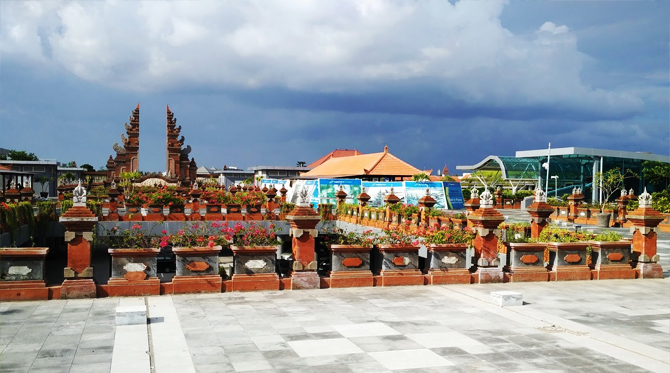
Ngurah Rai is the world's smallest international airport, covering only 285 hectares. The airport underwent a major expansion in 2013.
Now, it comprises a domestic terminal from where most travellers venture to eastern Indonesia.
The Bali arport International terminal has a Balinese architectural theme and has separate departure and arrival halls.
The departures area has 62 check-in counters that are equipped with electronic scales and luggage conveyors.
Ten of the international gates have Jet Bridges and automated aircraft parking systems. The international departure lounge areas have a total capacity of 3,175 passengers.
Operated since September 17, 2014, the New Domestic Terminal area is 65,800 square meter or four times larger than the old one.
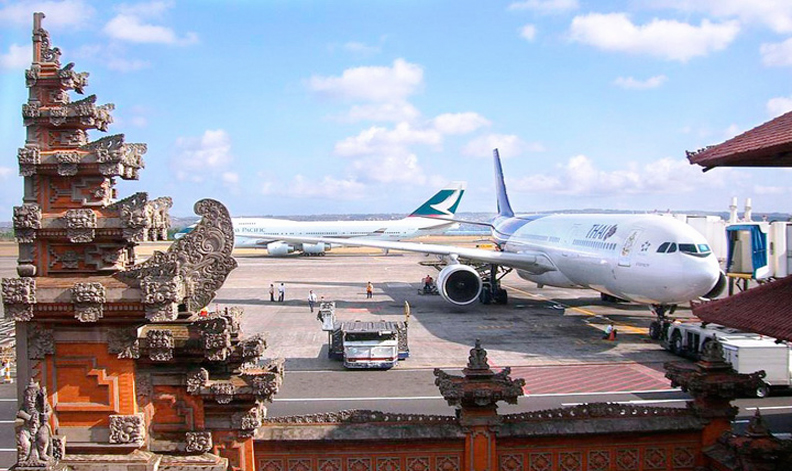
It can serve up to 9.4 million passengers a year, has 62 check in counters, four transit and transfer counters, 19 ticketing counters, eight boarding gates and seven arrival gates which are provided by five aviobridges (garbarata), and 5 unit conveyor belts.
The Bali airport operates a fleet of buses to ferry passengers to and from aircraft operating low cost flights which do not use an airbridge.
Domestic travelers and also some international travelers are often ferried to aircraft parked on the apron between the domestic terminal and the cargo terminal to the east of the International and Domestic terminals using these buses.
This terminal also has prayer rooms, smoking areas, showers and massage services. Various lounge areas are provided, some including children's play areas and movie lounges, broadcasting movies, news, variety, entertainment and sport channels.
Track the current status of flights arriving at Bali arport (DPS) Ngurah Rai International Airport → Flight Status – Arrivals and Departures.
Bali Weather & Seasons
Located 8° below the equator, Bali's weather and climate is characterised as tropical monsoon.
Bali has warm weather year round with 2 main seasons, the dry season (April to September) and wet season (October to March).
BALI WEATHERDuring the wet season, it rains almost every day, but usually for a couple of hours, after which everything looks even more green. It does however get very hot and humid as well.
The high season is July/August which is the peak of the dry season, but the island gets extremely overcrowded and hotel prices surge pretty high compared to other months.
The best months to visit are May, June and September where you can enjoy the beautiful weather without the crowds.
The warmest day over the next 25 days in Bali is forecast to be 19th August at 35°C (95°F) and the warmest night on 7th September at 25°C (77°F).
The average temperature over the next 25 days is forecast to be 33°C (91°F) . The average for August is 27°C (80°F) in Bali.
Best Time to visit Bali
Best time to visit Bali depends mainly on the weather and on high and low season, which does affect the overall price for accommodation.
High season is during the months of July and August, during Easter Holidays, and Christmas / New Year (December till 1st week of January). This is the time Bali is the busiest.
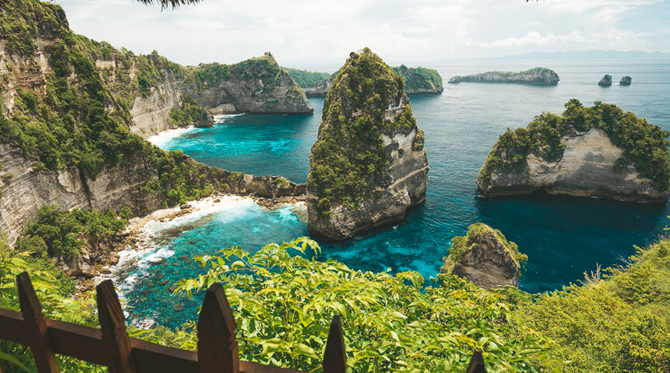
However, for many reasons, best time to come to Bali is April, May, June and September, just before and just after high season.
It's still dry season, it's slightly less humid, and room prices and villa rentals can be 30-50% cheaper than during high season.
Many shops offer sales and promotions, restaurants are less crowded in those mid-season months, and in general Bali is a bit more relaxed.
October is not too bad either, still much less rain than November (usually, check the rainfall chart).
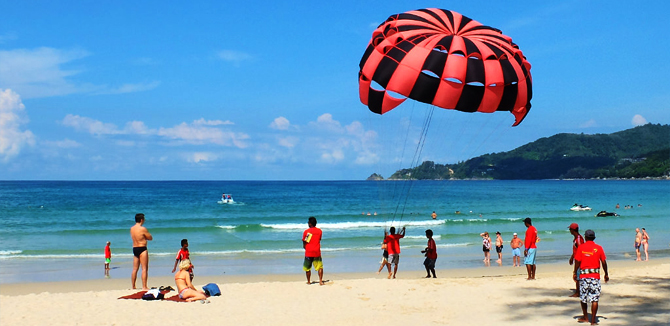
Those months are also the best time for water sport activities such as scuba diving, surfing, snorkeling, etc.
Waters are clear, crowd not too bad etc. Also major activities and attractions such as the family parks and fun things to do (Bali Zoo, Bali Bird Park, Marine & Safari Park,
Waterbom, White Water Rafting, Monkey Forest, etc) have less visitors which can make the experience far more enjoyable.
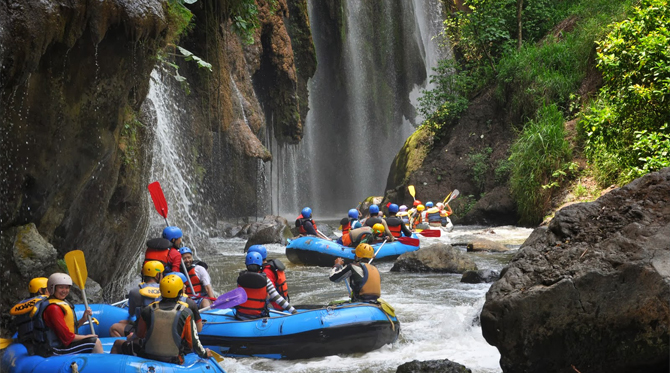
If you wish to explore the island and visit the main sightseeing spots, temples and go for a day trip and tour, then those months are also perfect.
And not to forget, in general the traffic and hustle bustle on the roads is more bearable.
Especially in Kuta, Legian and sometimes even Seminyak the narrow streets are packed during certain times in the day with cars and motorcycles.
Some tourists love it that way and could not imagine a holiday otherwise, but if you like it more quiet, then Kuta and Legian during high season might not be the best choice.
Bali Temples
There's probably more Bali temples than homes on the island. Many temples in Bali are actually shrines. However, the number of religious compounds might well be over 10,000.
The number is spread throughout the far-flung corners of the island, from mountain and hilltops to low-lying coastal areas.
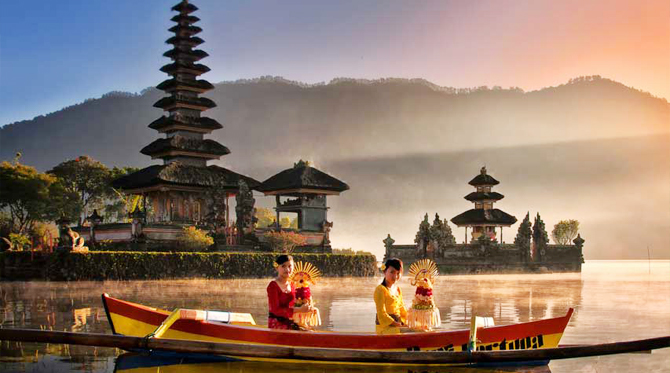
While this may be hard to believe at first, it doesn’t take much time on the island to notice that temples are literally everywhere.
Many of the island’s major tourist attractions, of course, are elaborate temples like a Taman Ayun Temple or Uluwatu Temple.
But a countless number of smaller ones exist in sleepy rural villages and even in each family compound.
Though it’s possible that the main purpose of your trip may be to surf or party on the beach, there’s simply no avoiding a visit to at least a couple of temples during your time in Bali.
Considering how unique Balinese temples are, learning a little bit about their symbolism and architectural features beforehand can greatly enhance the experience.
Balinese temples are complex. They could even be likened to living organisms that need to be fed and cared for in the form of festivals and offerings.
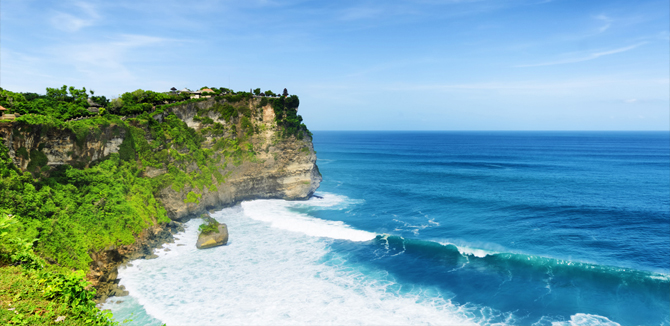
Considering what an integral part they are to Balinese culture, this article is only able to scratch the surface of all there is to know.
After learning a little bit about the basic temple layout and architectural elements, we’ll then go over some of the more noteworthy temples you can visit during your time on the island.
Balinese temples, or pura, have strong associations with the number three. Temples are divided into three spaces: an outer courtyard in addition to two holier inner yards.
Each temple also has spaces of worship for Hinduism’s three prominent deities: Brahma, Vishnu and Shiva.
And within the context of a Balinese village, there is also something called the ‘three temple system. Each Balinese village contains its own Pura Puseh, Pura Desa and Pura Dalem temples.
The Pura Puseh is dedicated to both the god Vishnu and the human founders of the village. These are usually situated facing Bali’s most sacred and largest mountain, Mt. Agung.
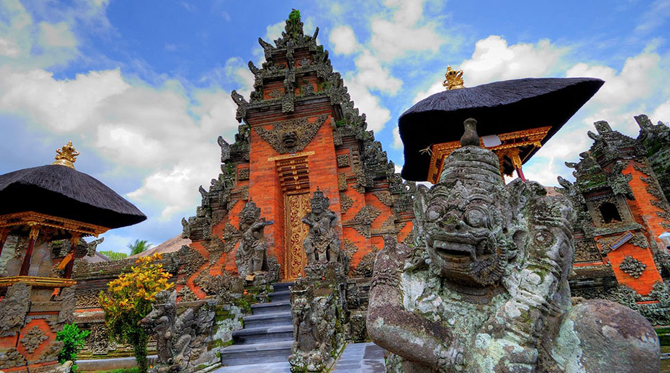
The Pura Desa is the temple of the local spirits as well as the god Brahma. These are usually located somewhere in the middle of the village.
Finally, the Pura Dalem is dubbed “the temple of the dead” and it typically faces the sea. Pura Dalem temples tend to be dedicated to Shiva or related deities like Kali, Durga, or even Rangda.
The whole death theme is not all somber, though, as these destructive forces are considered necessary for dissolving impurities, evil entities, and earthly illusions.
The Pura Puseh, Pura Desa and Pura Dalem temples are the bare minimum that any village in Bali must have, but it’s likely for there to be many more.
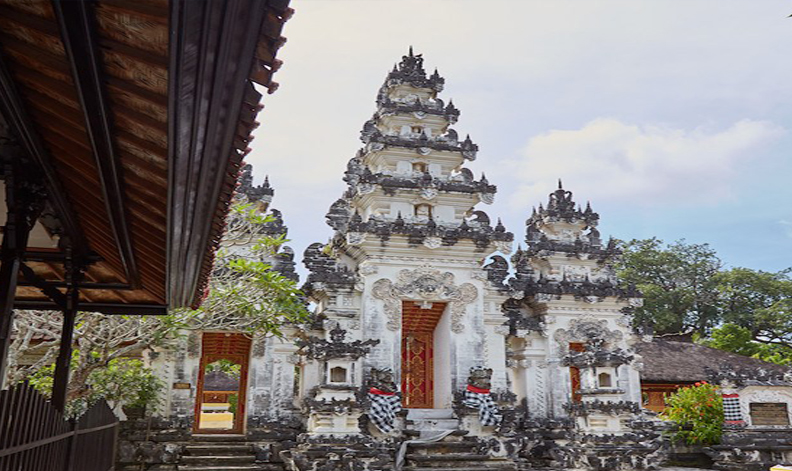
Many temples, it should be noted, fall outside these three categories, such as state temples or those belonging to the local village association. And of course, each family compound in Bali has its own temple as well.
Not only are there temples in a Balinese village for each god of the Trimurti, or divine Hindu trinity, but the three main gods are also symbolized in each individual temple.
This could be in the form of three tall thatched meru towers in which case the tallest one will most likely represent Shiva.
The divine trinity is also sometimes represented by color, with red standing for Brahma, black for Vishnu and white for Shiva.
The number three also plays an important role in the overall layout of each individual temple in Bali.
Upon entering a temple you’ll first find yourself in the jaba pisan, the intermediate space which acts as a bridge between the sacred space and the outside world.
The next section is the jaba tengah, or middle section, where things like gamelan performances or food stalls might be situated during a festival.
Finally, the most sacred and innermost area, the jero (or jeroan), is where things like the main tower and whatever important relics the temple may possess are located.
Individual shrines or towers within a temple might also be divided into three parts to represent the ‘three worlds’: the underworld, the human realm and the heavens.

This is a common theme throughout both Hindu and Buddhist temples, as can be observed at places like Borobudur.
Among the tens of thousands of temples in Bali, there are nine particular temples which are considered to be most important.
Confusingly, the list of temples will change depending on who you ask, but it’s the number that’s most important.
The Balinese consider these special temples to help balance out the forces of the entire island, like some kind of enormous version of feng shui.
ARCHITECTURAL ELEMENTS OF BALINESE TEMPLES
When visiting a temple, you’ll encounter all sorts of elaborate gates, shrines or other interesting looking structures. But you probably won’t always understand what you’re looking at.
Some temples will have special shrines dedicated to certain deities outside the Trimurti, for example.
Furthermore, you’ll likely notice a number of covered pavilions within the temple compound. These might be for gamelan performances or village meetings, but it’s often unclear to the casual visitor.
One thing all Balinese temples have in common, though, is that they’re all open to the sky.

The reasoning is so that the gods being summoned during special ceremonies can descend from the heavens into the temple before eventually returning home.
The list below is an outline of the most standard elements you're likely to find at a temple in Bali.
- Candi Bentar - As you approach a temple, the first thing you’ll notice is the candi bentar, or split gateway. These gates resemble a mountain that was split into two exactly even parts. To fully grasp the symbolism of the candi bentar, some basic familiarity with the legend of Mt. Meru is required.
Mt. Meru is a mythological mountain where the gods dwell. It appears not only in Hindu mythology but in Jain and Buddhist stories also. The Balinese believe that the original Mt. Meru, located somewhere on the Indian subcontinent, was transported to Bali by Shiva, where it was then split into two.
- Paduraksa - Most temples also contain inner gates known as paduraksa or kori agung. These gates separate the different areas within a temple, such as the jaba pisan from the japa tengah (see above).
Unlike the candi bentar, these gates are not split into two. Furthermore, you’re likely to find the face of Bhoma, the Balinese Jungle God. While the creature may look fierce, he merely acts as a protector, scaring the evil spirits away from entering the holier parts of the temple.
- Meru - Aside from the temple gates, the most distinguishing characteristic of Balinese temples are their multitiered pagodas of varying numbers of thatched roofs. These are situated in the holiest and innermost jero section of a temple. These towers also symbolize Mt. Meru and are even simply referred to as meru.
Different towers may be dedicated to different gods, or sometimes even individuals or local mountains. Meru towers have either 3, 5, 7, 9 or 11 tiers – a sequence of numbers considered sacred not just in Bali but in cultures throughout the world. It’s said that a Balinese temple’s importance can more or less be determined by the height of its highest meru.
- Bale Kulkul - A bale kulkul is a special tower housing a drum. The drum is used to call participants for village meetings or announce deaths, among other things. During special ceremonies, when gods or spirits are believed to descend down upon the temple complex, the kulkul might be banged on to announce the deity’s arrival.
The drum itself hangs from the ceiling of the thatched roof. It’s typically a hollow wooden cylinder with a slit down the middle, which is then struck with a special type of hammer.
- Padmasana - Above we went over the importance of the Trimurti, or the holy Hindu trinity of Brahma, Vishnu and Shiva. Ultimately, though, Balinese Hinduism is a monotheistic religion.
Their supreme god is known as Sang Hyang Widhi Wasa. This deity, however, is so beyond normal human comprehension that it cannot be symbolized by a single statue or painting.
Considering how visual and symbolic Balinese culture is, how do they go about representing something which can hardly be comprehended?
They use what’s referred to as a padmasana, or an empty throne on which the formless Widhi Wasa is said to sit. The padmasana is unique to Bali and you won’t find it in other Hindu countries like India.
It’s said to have been created by the 16th century priest Dang Hyang Nirartha, who also influenced many other aspects of what make up Balinese Hinduism today.
Bali Nightlife
Every night of the week, visitors and local residents hit Bali’s many pubs, clubs, and beach clubs bars.
Low-key spots, with affordable drinks let you unwind and make new friends, while upscale bars and pubs attract you with delicious cocktails, imported beers, fantastic food, and world-class musical entertainment.
Not keen on dressing up for the night and want to stay in your shorts and t-shirt? No worries. Bali will have a spot where you’re welcome.
Want to get dressed up in your fancy gear and step out to be seen? Then you’ll feel right at home here in Bali. The island offers a wide range of nightlife experiences for visitors of all type.
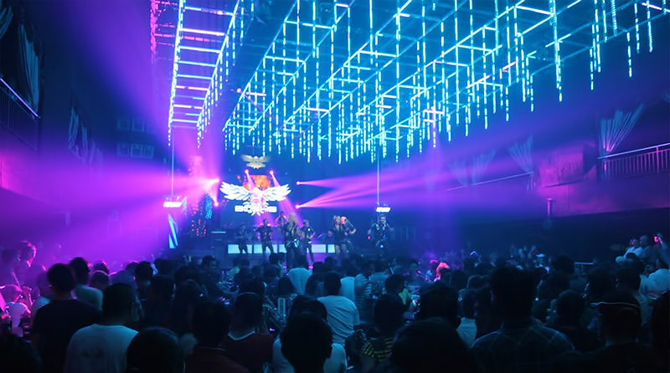
Bali has long been a center for clubbing and going out at night. Nearly half a century ago, the island was a popular stop for hippies and surfers, and its relaxed and tolerant culture has allowed a thriving party scene to grow over the decades.
Its relative proximity to Australia, Japan, Singapore and the continous stream of visitors from those countries turned Bali into a world-class destination for nightlife.
Bali has no enforced opening and closing times for clubs and discos allowing them to stay open till late, with the music sometimes still playing at sunrise.
Although the real parties and action happens after midnight, going out might start early, with happy hours available in many restaurants, bars, and clubs, and sunset drinks are a daily pastime, whether in a luxurious beachside lounge in Seminyak or on a bench by the waves in Kuta.
Bali nightlife is diverse, yet certain types of crowds, venues, and music are found more in specific areas.
Kuta tends to pull in a younger, wilder crowd with megaclubs, ultra-cheap drinks, and a musical focus on reggae, top 40, R&B, and mainstream dance music, while Seminyak typically attracts a hipper, more refined group of clubbers.
Here, also most expatriates hang out. The focus is on beautiful venues with top of the line sound systems and international DJs playing house, techno, dubstep, and other cutting edge sounds.
Drinks are of a higher quality, often made by the most skilled bartenders with imported ingredients. Make no mistake though, Seminyak’s clubs can get as wild as they come.
New hot spots often pop up and then shut down as soon as they get popular. Some of Bali’s clubs are rowdy and wild, some are hip and contemporary, and other more elegant and sophisticated. These can all be sampled in one night by simply grabbing a taxi and club-hopping.
Some mega clubs have made things easier for those who don’t want to travel by offering restaurants, bars, and multiple dance floors with different music styles, all under one roof.
Live music is available in Kuta, Sanur, and Denpasar, and tends to draw also a local crowd. Cover bands are common, as is karaoke, and the scene is more about drinking and meeting someone new than all-night dancing.
When all of the clubs and bars shut down, clubbers can keep going at a number of afterhours spots or at one of the late-night restaurants or street food centers that cater to the night owl.
Bali Dances
Balinese dance is an ancient dance tradition that is part of the religious and artistic expression among the Balinese people of Bali island, Indonesia.
The Balinese dance is dynamic, angular and intensely expressive.Balinese dancers express the stories of dance-drama through the bodily gestures including gestures of fingers, hands, head and eyes.
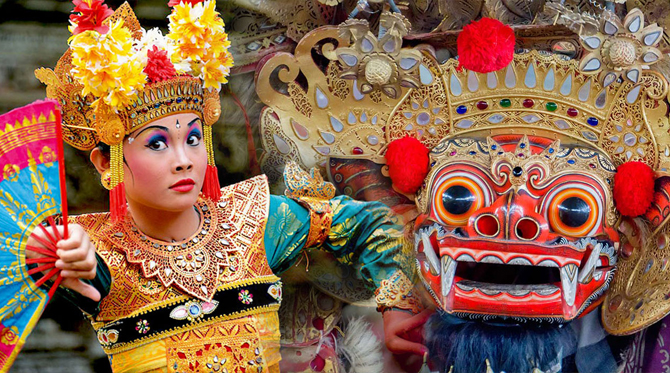
There is a great richness of dance forms and styles in Bali; and particularly notable are those ritualistic dance dramas which involve Rangda, the witch, and the great beast Barong.
Most of dances in Bali are connected to Hindu rituals, such as the Sanghyang Dedari sacred dance than invoked hyang spirits that believed to possess the dancers in trance state during the performance.
Other Balinese dances are not linked to religious rituals and created for certain purposes, such as Pendet welcoming dance and Joged dance that is social dance for entertainment purpose.
In Bali there are various categories of dance, including epic performances such as the omnipresent Mahabharata and Ramayana. Among the dance traditions in Bali are:
- Barong, king of the spirits
- Baris dance, war dances
- Cendrawasih dance, the bird of paradise
- Condong dance, a basic dance, preface to Legong
- Legong dance, a refined dance
- Kecak dance, the Ramayana monkey chant dance
- Janger dance, a sitting dance with swaying movements
- Pendet dance, a simple dance performed before making an offering at a temple
- Topeng dance, a mask dance
Bali Beaches
Being the most well-known travel place in Indonesia, Bali has one of the best beaches in the world.
Many come to Bali maybe for the culture, the arts, the temples, diving, surfing or even the food, but one thing for sure it is also for the beaches.
Travelers visit Bali for its long stretches of white sand beach, the crystal clear sea for swimming, strong waves for surfing and volcanic black sands for sunbathing.

There are many types of beach in Bali, from those with big rocks created by corals or lava to those covered wholly with white or black sand.
Depending on what you want to do at the beach, there are a number of beaches for you to choose from.
Whether you are a swimmer or not or if you are with kids, you may well choose from these beautiful beaches below. Look out for the high tide when swimming.
Here is a list of the most popular Bali beaches for you:
#1. Kuta Beach - Further down the line from the city Kuta is the Kuta beach. The waves are higher here and the currents are strong making it a perfect beach for surfers.
But of course it means not so much for swimming. The beach is always crowded with locals or tourist, mostly for the vibe and energy that circles around here.
At night you can find the Kuta beach parties among the beach clubs that are guaranteed to entertain.

#2. Nusa Dua Beach - A seemingly endless stretch of powder white perfection, Nusa Dua Beach is so flawless, it almost looks manmade.
It borders the coastline of Nusa Dua’s resort area, fringed by manicured lawns and five-star hotels that have been tastefully sheltered by palm trees and natural building materials.
Not only are the beaches impeccably clean and the waters calm, the shoreline is full of family-friendly restaurants, watersports and even a shopping complex.
So it’s the ideal destination for a fun-filled family day out that won’t leave the little ones hot and bothered thanks to plenty of places to cool off and recharge.
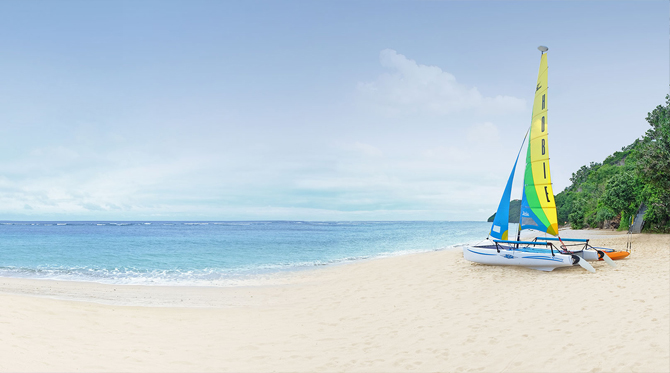
#3. Seminyak Beach - If you want to be in the heart of Bali’s oceanfront action, then Seminyak Beach is the place for you.
Along this impressive 5km stretch of powdery white sand, you’ll find beach bars aplenty, five-star hotels and restaurants just footsteps from the waves, and world-famous beach clubs dotting the sand.
Beginning on the outskirts of crazy Kuta, trailing all the way up to the coastal corners of Canggu, Seminyak Beach is a holiday destination in itself.
Learn to surf in the gentle whitewash of the waves, soak up the sunshine on a squishy sun bed, or settle into a comfy, colourful beanbag at La Plancha for a round of sundowners – Ibiza-style beats included.
#4. Echo Beach - What was once the go-to destination for a romantic beachfront barbecue has now become one of the coolest oceanfront spots to see and be seen.
Echo Beach is the watering hole of Canggu (quite literally) with countless surf spots in every direction and shabby-chic bars dotted along the black sands to enjoy the views.
And what a view there is. Expect beach babes in their Brazilian-cut bikinis, scruffy haired surfer dudes with sun-kissed bods, and beloved Bali dogs with their expat owners taking a sunset stroll.
This lively, community-vibe coastline goes from a playground of sun and surf by day, to a wild party spot by night. Bring an acoustic guitar for extra street cred, and don’t forget the dog treats.
#5. Jimbaran Bay - This long, expansive, soft white sand beach is not only well known for its gorgeous scenery (the glittering sands stretch for a full 3km), but also as the spot where local fishermen sell their fresh-from-the-net fish each morning at the bustling markets.
As the island’s seafood hub, it’s no surprise then that you’ll also find a number of beachfront barbecues dotted along the coastline, cooking up the day’s catch for your grazing pleasure as the sun sets.
For a romantic seafood dinner, head to the bay before dark and choose your ocean treats from the display to devour just a few minutes later, or if it’s sunshine you’re after, find a quiet spot away from the stalls and enjoy the calm waters from dawn until dusk.
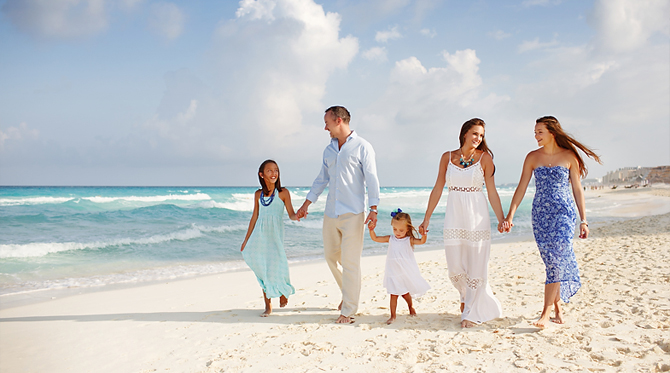
#6. Balangan Beach - Located in the South of Bali on the Bukit Peninsula, Balangan Beach is best known amongst the island’s surfing crowds and those looking for a laid back beach experience without the throng of touristic beach clubs.
Ocean babies can enjoy the aquamarine waters at high tide, and sunbathers can lie beneath the many loungers and umbrellas that line the sandy beach.
This quiet strip is still fairly underdeveloped with just a few local warungs serving home-cooked Indonesian food and icy cold Bintangs, and since it’s blessed with awesome waves for both beginners and pros.
Balangan attracts the surfy, backpacker types who prefer cool tropical vibes over a pumping party scene.
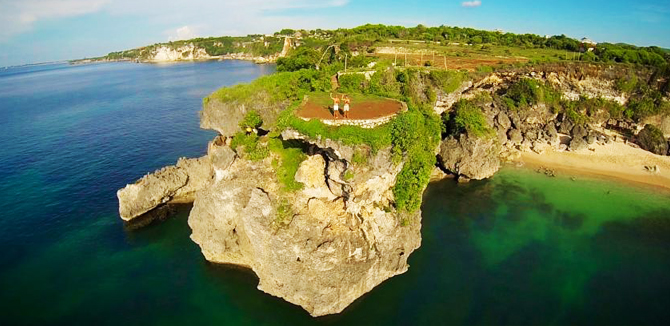
#7. Keramas Beach - With Mount Agung behind you and pumping waves in front of you, Keramas Beach is a sight to be seen indeed.
Sitting on the east coast away from the crowds, Keramas is best known for its standalone beach club destination, Komune Bali.
This resort and beach club combo sits on the sand with a stunning infinity pool at the helm, facing out to the black sand beach and sparkling ocean out yonder.
Settle in to the oceanfront day beds, graze by the pool or visit at dusk when the nightime surf sessions take centre stage.
Double points if you time a visit in conjunction with the annual World Surf League competition that attracts superstar surfers from around the world.
#7. Sundays Beach Club - Another South Bali gem, Sundays Beach Club at the Ungasan Clifftop Resort boasts a private white sand bay, stunning turquoise blue waters and an offshore coral reef housing Nemo and his friends.
Hidden discretely at the bottom of a dramatic cliff face, this paradisal spot can only be reached by an inclinator taking you directly to the club.
Don’t miss the bonfires on the beach at sunset, and come hungry because you’ll want to tuck into Sunday’s delicious island-inspired menu by famed Aussie chef, James Viles.
Just be sure to leave enough space for some serious water-based frolicking, like snorkelling, stand-up paddle boarding and kayaking the crystal clear waters.
#8. Padang Padang Beach - You might recognise this beautiful bay from the ever-famous “Eat, Pray, Love” movie, where Julia Roberts falls head over heels for her Brazilian hunk.
Chances are, you’ll fall in love here too, not only with the bronzed surfer crowds, but with the calm cove-like waters rolling off the bright white bay, framed by dramatic rock formations and bordered by world-class waves.
Though Padang Padang is a relatively small beach about 10 minutes north of Uluwatu, the setting is simply stunning.
The best time to visit is early in the morning around sunrise when you can see Padang Padang in all its dazzling, natural glory, and before the throng of visitors descend on this spot in the hope of spotting Ms Roberts.
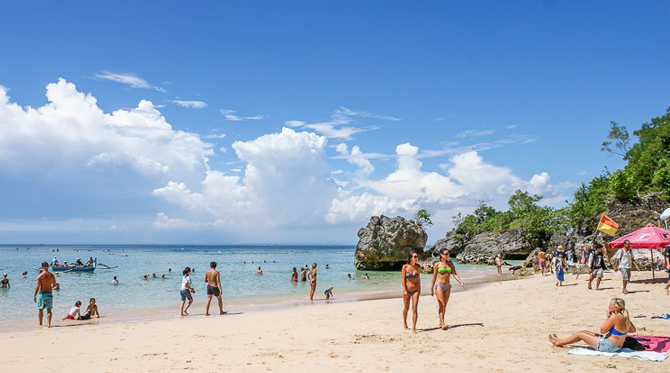
#9. Medewi Beach - In prime position along Bali’s sunset coast, Medewi is a lesser known beach on the west side of the island that offers a glimpse of Bali before tourism struck.
With remote villages and wide open rice paddies lining the palm-studded coastline, come here for a tranquil escape not an action-packed day at the beach – that is, unless you’re a keen surfer.
Flocked mostly by visitors in search of uncrowded, world-class waves, Medewi is an isolated surfing destination that doesn’t require a flight to get to.
But is far enough away from the crowds to guarantee a quieter sesh in the water. Stick around for golden hour, as that’s when Medewi’s magic really shines.
#9. Suluban Beach - This dreamy destination might well be directly below the famous and bustling Single Fin bar and the main access point to the world-renowned Uluwatu surf break, but come low tide, this spot at Suluban Beach is a true hidden treasure, and the best for a secret swim.
Set against stunning dramatic cliffs, the water here is as turquoise as it gets. To access this little piece of paradise, you’ll need to walk down the steps at Uluwatu, through the caves and onto the sand.
Remember, when it’s high tide this swimming spot is inaccessible, so you’ll need to check the tide times for your trip here, and don’t forget to pack your bathers.
#10. Sanur Beach - If it’s a leisurely day out at the seaside that you’re after, then head to family-friendly Sanur for an easy-breezy day at the beach.
Besides its seemingly never-ending stretch of white sand, Sanur’s main beachfront attraction is without doubt the coastal promenade that extends over 5km long.
This ocean path curves past resorts, beachfront cafes, wooden fishing boats under repair and quite a few elegant old villas built decades ago by the wealthy expats who fell under Bali’s spell.
Take a romantic stroll with your partner, or get some exercise on a bicycle with the family – best enjoyed early in the morning as Sanur is in prime position for spectacular sunrises.
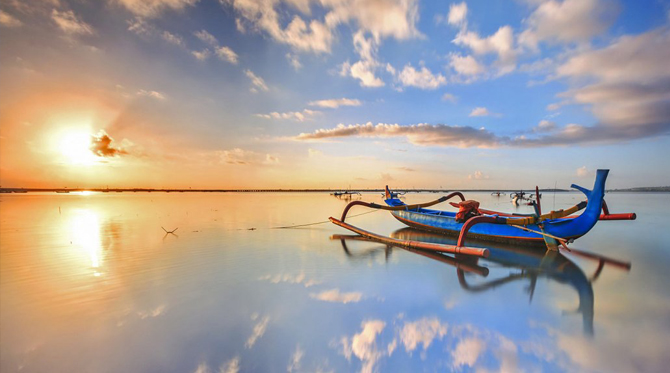
#11. Karma Beach - Part of the stunning Karma Kandara resort, this luxury and private beach spot brings the vibes of a swanky Mediterranean island, along with crowds of trendy globe trotters looking for exclusivity in a totally chic setting.
The sea is a perfect shade of azure blue and great for snorkelling and water sports, while the crescent white sands are sprinkled with beach babes and their baes sipping on designer cocktails, playing a spot of beach volleyball.
Or simply bronzing beneath the beach-chic cabanas and tucking into delicious wood-fired pizzas from the natural bamboo restaurant. Heaven really is a place on earth.
#12. White Sand Beach (Pasir Putih) - Pasir Putih, also known as White Sand Beach or Virgin Beach, is a remote, off-the-beaten-path beach that rewards the most adventurous of road trippers.
It’s located on the East Coast of Bali, near to the village of Candidasa, and with its pristine soft white sands that dramatically contrast to its volcanic black sand neighbours, it seriously stands out.
When you see the “white sand beach” sign, follow the dirt track until you reach the carpark.
You’ll spot the line up of local seafood BBQ stalls (perfect for a sea view lunch) and the calm, clear waters that make White Sand Beach a lovely spot for swimmers, too.
#13. Bingin Beach - Look out for the signs made of recycled wood, or follow the small groups of Bali’s cool crowds with surf boards in-hand and the lack of shoes or sandals on their feet.
Bingin Beach is a boho hideaway that’s hard to find unless you know where you’re going – or who to follow. With perfect waves and small sandy coves for swimming at low tide, this cliff-base beach is a favourite for Bali’s sun soakers and surfers.
You’ll need to be relatively fit to get to and from the beach (there are uneven, rocky steps from the top of the cliff to the sands), but your efforts will certainly be rewarded.
Dozens of affordable beach stays line the cliffside too, making this a good spot for budget trips or a good old, no-frills sunset Bintang on a blanket.
There are some great healthy cafes here too, perfect for a post-surf refuel and insta-ready sunsets.
#14. Gunung Payung Beach - Gunung Payung, also known as Secret Beach, is the epitome of a picture-perfect, postcard paradise.
In fact, we were a little hesitant to include this in our roundup, since we’d like to keep this little treasure to ourselves. Alas, we can’t keep this gem a secret.
Think powder white sands, warm tropical waters that are as flat as a duck pond at low-tide, and if you’re lucky, not another human in sight. This beach isn’t for the faint-hearted though.
It’s a 301 step trek up and down (we counted) and once you’re down there, there’s no restaurants for refreshments or shady sun beds, just one local guy who sometimes has a cool-box with cold water and Cokes.
And if he’s feeling strong enough, will also bring his single sun bed and umbrella down from the top carpark for the day for hire. It’s well worth it though, just don’t forget to hydrate.
#15. Balian Beach - Home to a growing number of expats and surf fanatics, Balian Beach draws in the cool crowds with its pounding surf, instagram-friendly dunes and knolls.
New boho cafes and bars popping up every other day – all of which just so happen to overlook the world-class waves from the towering cliff face above.
Whether you simply stroll along the sprawling black sands, brave the water or kick back with a sunset beer post-surf.
Balian Beach has an undeniable charm that keeps us coming back every other weekend, and it just so happens to sit in prime position on Bali’s west-facing sunset coast, too.
#16. Thomas Beach - Ever since the opening of some cool Uluwatu restaurants at the top of this hidden bay, Thomas Beach is no longer a secret – though it’s still one of the quietest beaches in the Bukit.
Accessible only via a gravel lane and then a winding set of crumbling stairs, this secluded strip of white sand beach is well worth descending down for.
Fringed by turquoise waters and dramatic boulders that protrude from the sand, this is postcard-perfection to a tee.
Bring a sarong and some water to stay hydrated, because you won’t find any restaurants or squishy sunbeds on this remote shoreline.
#17. Amed Beach - With black sands and soaring volcanoes on the horizon, Amed isn’t your typical beachfront vista, but boy is it a good’un.
Sitting on Bali’s northeastern coast, Amed is known for its dramatic landscapes that guarantee some awe-inspiring holiday pics.
And if you’re into diving or snorkelling, Amed is also home to one of the island’s most vibrant reefs – a coral garden that’s as colourful as it is popular.
An adventure beneath the waves here often involves a trip to nearby Tulamben too, to explore the sunken US Liberty Shipwreck that’s teaming with life and aquatic beauty.
#18. Lovina Beach - Lovina is well-known for its dolphin tours: half an hour before sunrise, more than 100 boats carry tourists out to sea where, as the sun comes up, pods of dolphins frolic in the bow waves.
Many tourists stay one night for the dolphin trip and then leave – missing out on Lovina’s chilled beach-holiday vibes. The beach at Lovina is black volcanic sand and the sea very calm; lovely for wallowing.
Take your camera and wander east from the main beach, and you’ll come across brightly painted fishing boats resting on the sand. As the sun goes down, the silhouettes of Java’s volcanoes are cast on to the horizon.
#19. Blue Lagoon Beach - Just over the hill from Padang Bai (fast-boat terminal for the Gili Islands) there is a little secret beach surrounded by palm trees, cut off from the rest of the island by volcanic rock headlands.
The white sand is perfect for whiling away hours in the sun, and the beach is edged with trees providing some shade.
Coral reaches almost all the way to the beach, so rent snorkelling equipment from one of the beachside warungs and explore the underwater world.
#20. Geger Beach - Located from the highway heading to Nusa Dua, Geger beach is a beautiful white sand beach glistening in the sun.
The sea is calmer here in comparison to Kuta or Balangan beach, though sometimes it may get a bit rough by the evening so please beware.
Local seaweed farmers do their work here sometimes so if you are lucky you can enjoy watching them going about their livelihood.
There are many cafes dotted along this beach making it famous for Sunday brunch or just for drinks and there is a temple at the end.
#21. Bias Tugal (Tugel) Beach - Also known as Pantai Kecil (little beach) to the locals or white sand beach to the travelers, this deserted beach is one of the best-kept secrets.
Tucked away near Padang Bai and west of the harbour is somewhat hidden and only accessible after a 500m trek down a rocky path.
After the trek, you will be greeted with stretches of white sand beach and sparkling blue sea with swaying coconut trees.
Current may be strong here and not for beginner swimmers, but you can always just soak up the sun in solitude by the sand.
#22. Dream Beach in Nusa Lembongan - Lembongan is a small island about 7km out of the sea from Bali, with big rocks and small vegetation with spots of sandy bays.
One of these bays in Nusa Lembongan is Dream Beach. It is known for its serene sea lapping and white sand. Most people stay longer at this island to explore all the beauty of it.
It is still largely undeveloped unlike the rest of Bali and lets one feel the sense of going back in time, just enjoying the natural beach.
How to Get to Bali
With the increasing number of direct flight to Bali from some other parts of the world, it makes it easier to go to Bali.
International flights arrive at an airport near the Indonesian island's capital, Denpasar.
Many airlines fly from the United States to Bali, though flights usually entail at least one layover at a hub airport like Hong Kong, Changi, Singapore or Narita, Tokyo.

From Bali, flight to Jakarta is about 1.5 hours, to Singapore and Perth (Australia) 2.5 and 3 hours, to Hong Kong about 4.5 hours, and to Sydney/Melbourne about 5.5 to 6 hours, with various airlines offering their services.
Please check at “airline info” for more information about flight schedules. Just make sure you look for “Denpasar (DPS)” instead of “Bali” in airline time tables.
Intrepid travelers can catch a ferry for the last leg of their trip to Bali from the nearby Indonesian island of Lombok, Gili Islands and other small islands.
How to Fly to Bali
Major airlines that fly from the United States to Bali include Singapore Airlines, Korean Air, Cathay Pacific, Delta Air and American Airlines.
For the most competitive airfares, use a comparison website like Skyscanner or Kayak and begin searching for flights three or four months before the departure date.
Input the departure airport and the designation "DPS" as the destination airport. Due to the distances involved and time zone differences, allow two days' traveling time to arrive on the intended arrival date.
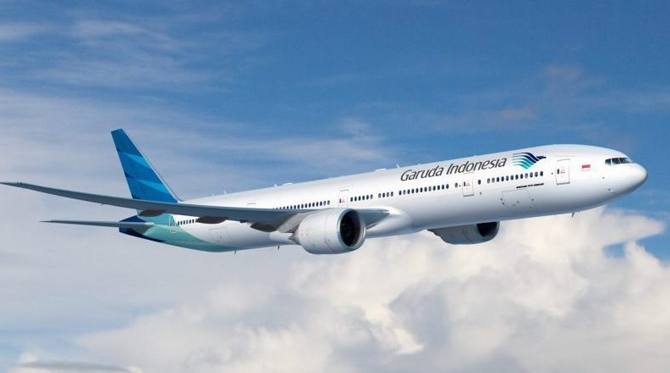
For example, to arrive on July 31st, input July 29th as the start date. Layovers of 24 hours or longer help ease the effects of the long flight to Bali, and cities like Hong Kong and Singapore offer plenty to see and do on a short break.
Ferries to Bali
There are a number of ferry routes to Bali, all of which dock in Padang Bai on the south-east coast, Benoa the south-central coast, near Kuta, and Gilimanuk in east coast.
For many backpackers, crossing the Bali Strait between Java and Bali is the main way of reaching “paradise” on the Island of the Gods.
While some people may take the more expensive and direct option of flying to Bali (usually from Surabaya or even as far back as Jakarta), the ferry is a more authentic experience.
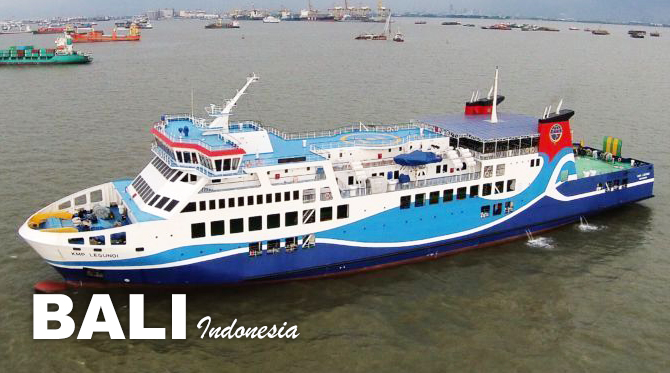
On the Java side, the port at Ketapang is very convenient was there’s a bus station and train station nearby, which have comprehensive services to other destinations around the island, such as Probolinggo (for Mount Bromo), Yogyakarta, Malang, and Bandung, as well as the nation’s capital.
The crossing from Java to Bali by ferry takes only 25 minutes, although this does not include the time taken for loading and unloading the cars and small amounts of cargo. The ferries run 24 hours per day and depart every 20-30 minutes.
There are ferries sail from Lombok to Bali 17 times per day, and passengers can travel from Gili Island to Bali 33 times per day.
Ferries also travel to Bali from the nearby small islands, Nusa Lembongan, Nusa Ceningan and Nusa Penida. The fastest and slowest ferry crossings are from Lombok to Bali.
The Freebird Express ferry completes the journey from Bangsai, Lombok, to Amed, Bali, in 45 minutes, while Scoot Fast Cruise's ferry takes four hours and 45 minutes to cross from Sengigi, Lombok, to Sanur, Bali.
Embassy & Consulates in Bali
Bali is one of the most popular tourist destinations in the world, and even though it is a small island, we are blessed that quite a few countries run consulates in Bali.
Not every country has a consulate in Bali and the embassies are located in Jakarta, the capital of Indonesia.
But for most travellers we have good news, that in case of need of assistance, they do not need to travel to their embassy.
In most cases you will never need their services anyhow, and that's a good thing. But sometimes things happen where we will have to go to our embassy or consulate to sort things out.
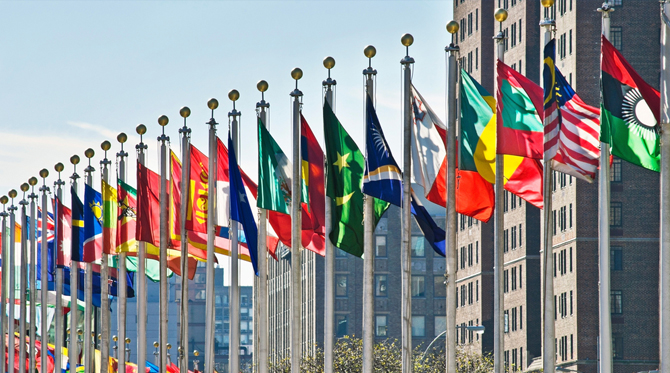
The consulate helps you with services about passport and citizenship issues, child and family matters and provides you with assistance in case of an emergency.
So, if you lost your passport or it got stolen, or you end up with no more money and got stuck on the island, if you are moving to Bali or face other obstacles that seem hard to solve.
Then it's pretty nice to know you are not alone and you can connect with competent people and receive their help and support.
Here is a list of the embassy & foreign consulates in Bali.
Bali Villas
The new trend in accommodation, Bali villas are boutique, private lodgings offering the ultimate in luxury and seclusion.
Gaining in popularity, these villas are a refreshing deviation from your typical resort or hotel accommodation experiences.
Featuring more spacious living quarters and a wealth of state-of-the-art facilities, most are often self-catering with additional options for in-villa catering.
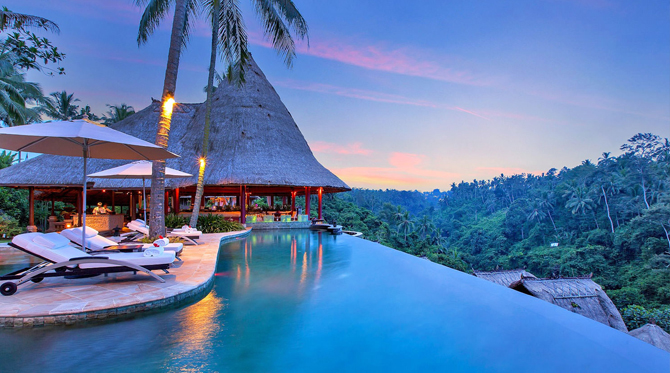
More than just a place to sleep, villas are designed to be your lavish home-away-from-home with outdoor areas, private pools and personal staff dedicated to servicing your needs.
Bali villas feature the same service and facilities of a 4 or 5 star resort but on a more exclusive basis, with less rooms offered to ensure an intimate and peaceful holiday experience.
There are a fantastic range of deluxe villas available across Bali, including the most popular tourist destinations such as Seminyak, Sanur, Ubud and Jimbaran.
Surprisingly affordable, Bali villas are a popular alternative to many traditional forms of accommodation as they offer far greater value for money.
An obvious choice for honeymooners and couples on romantic getaways, families, large groups and young travellers also enjoy the indulgent and economic advantages of choosing to stay in a Bali villas.
Why choose a villa over resorts or hotels?
✓ Personal service from a friendly and experienced staff.
✓ Great value - enjoy more space and far superior facilities for a little bit extra.
✓ Ideal for romantic getaways, family holidays or summer vacations.
✓ Ability to customise your own holiday experience through attention to detail.
✓ Wide range of villas to choose from - heaps of villas specialising in their own holiday experiences.
Regions with Bali Villas
- Seminyak Villas
Affectionately known as Bali's villa capital, Seminyak offers a long list of villa accommodation options. - Jimbaran Bay Villas
Renowned for its high end accommodation, Jimbaran Bay villas offer fantastic facilities including day spas. - Ubud Villas
In perfect harmony with their beautiful natural surrounds, Ubud villas are nestled of stunning mountain ranges. - Sanur Villas
Offering a smaller selection of sophisticated villas, Sanur offers a more relaxed and peaceful atmosphere. - Kuta Villas
Kuta as one of Bali’s most famous beaches is profuse with accommodation choices, but these selections offer you a better sense of privacy and intimacy, together with a host of luxurious services and facilities. - Nusa Dua Villas
Nusa Dua mostly comprises some of the island’s top five-star luxury accommodations, and these selections of the most popular Nusa Dua villas will make it easier for you to decide from the many great choices available.
Bali Hotel & Accommodations
Bali is a popular holiday destination with local and International travellers alike and is renowned for budget accommodation, luxury villas, holiday resorts and everything in between.
With so many options to choose from, finding the accommodation that's right for you can be a challenge.
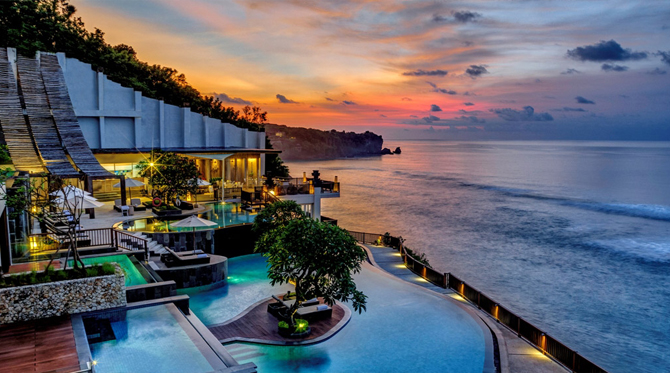
But don't worry; whatever your accommodation needs, Bali has it on offer, and the small size of the island and incredible range of hotels, guest houses, and villas means that no matter what you have planned for your vacation, you can be sure to find the perfect place to rest your head.
Finding What You Are Looking For
Bali’s hotels, villas, and rental properties offer incredible comfort and value, and are as diverse as the travelers that visit them.
From budget guest houses to five-star luxury hotels, Bali offers great deals that suit any budget.
But we all know how daunting and confusing the task can be finding the perfect holiday place for oneself - or if you are in charge, for the entire family. There are a lot of factors to consider.
Take your time, Bali is small but its diversity leaves us astray at times, if we do not get a feel for our preferences and the areas where we can most likely find what we are looking for.
We suggest to spend some time on this page to get to know Bali, and its different tourist areas and what to generally expect there. This helps you when you run through the hotel and villa listings.
What's your preference and budget?
The variety of things you can do and expect while enjoying your holiday is simply mind-blowing.
Travelers can dive into the busy social scene in popular areas or enjoy an exclusive getaway in the boutique hotels, tranquil private villas, and vacation rental properties found all over the island.
Backpackers will be surprised by the clean, relaxing accommodation available on a tight budget, while those who want luxury can live like royalty at a reasonable price.
So before you start your search through 4000+ Hotels, Resorts and hundreds of private villas get a feel for what's your preference and read up a bit on the areas and what they are offering in general.
Then, while browsing through Booking.com as our recomended hotel online booking partner site, make use of the filters, map views, select the matching areas and decide on a rough budget; this will help you to get fast results on deciding where you wish to stay on Bali and short list the properties.

Have a penchant for sun, sand and surf, and preferring a beachfront resort? The famous beach resort areas might suit you, your family or friends well.
Try Kuta, Legian, Seminyak, Nusa Dua or Sanur. If Bali's scenic valleys with flowing green rice fields and rich arts and culture are more of your liking, choose Ubud.
Bali hotels here are mostly ready to welcome you with unique villa settings. Most offer a blend of traditional Balinese architecture and modern amenities.
Honeymooners looking for a remote escape can opt for a boutique resort in East Bali or the island's north.
Try the eastern coast of Candidasa or the diving and snorkelling haven of Amed. Bali's north is home to calm beaches such as Pemuteran Bay and Lovina. The latter is also famous for its dolphin spotting tours.
Bali Visa & Immigration
All you need to know about Visa and Immigration when you come to Bali
Even though, the visa requirements for Indonesia have become much less complicated over the years, still, there is a lot of confusion out there.
We want to help you to clarify the most important facts if you wish to travel to Bali and Indonesia.
We would have loved to come up with a short article that would explain all the options very briefly, however, particularly if you intend to stay longer than 30 days, there are several options we need to address.
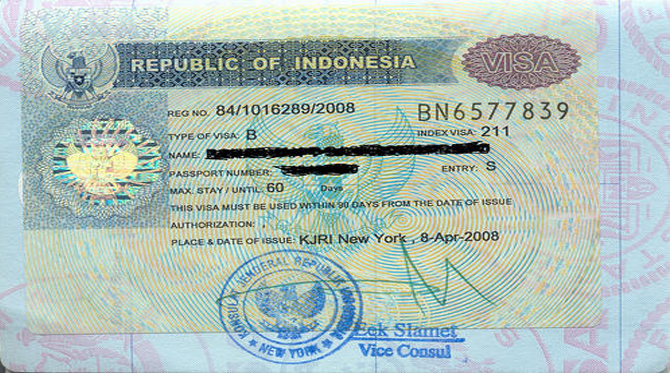
So, it's advisable to spend a little time on this article to figure out your best visa "solution".
If you only want to visit as a tourist for less than 30 days, then citizens of more than 140 countries have nothing to worry about, and please make sure the passport is valid 6 months!.
Key Facts for Bali and Indonesia
- Visa Regulations are based on your passport / nationality.
- A Free Entry Stamp CANNOT be extended.
- Passport must always be valid 6 months (for social visa 12 months) from day of arrival. No exceptions.
- Keep a page on passport empty for stamp or visa sticker!
- Day of arrival counts as day one, day of departure counts as full day.
- Penalty fee for overstaying IDR 300,000 per day.
- Don't bring more than IDR 100,000,000 in cash (ca. AUD 10,000).
- In need of sponsor letters, KITAS, Visa extensions, etc working with a reliable agent is strongly recommended.
Main Criteria that define visa requirements
- Your nationality (passport).
- Purpose of your visit (social/tourism or work etc).
- Length of Stay.
Bali Visa on Arrival (VoA)
The Visa on Arrival for Bali Indonesia, also referred to as VoA, has been the main visa, most tourists have used in the last decades to enter Indonesia.
It has nothing to do with the the newly introduced Free Visa Facility where citizens from 169 Countries Get Visa-free Facility can enter Indonesia through 124 Immigration Checkpoints in airports, seaports and land border.
Tourist Visa Free Facilities cost USD 35 are valid for 30 days and free visa cannot be used for journalism. It is not extendable and you cannot convert the visa into a different visa.
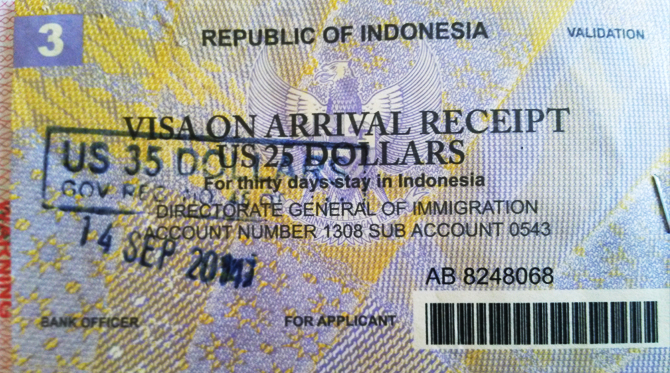
The visa exemption facility can be used for tourism, family visit, social visit, art and cultural, government duty, to deliver a speech or attend a seminar, international exhibition, meetings with head office or representative office in Indonesia, or transit.
If the 30 days of Visit Visa Exemption facility feels insufficient, visitor still can apply for Visa on Arrival (given for 30 days and extendable for another 30 days) or Visit Visa.
List 169 Countries Get Visa-free Facility in Bali, Indonesia
The Visa on Arrival for Bali Indonesia, also referred to as VoA, has been the main visa, most tourists have used in the last decades to enter Indonesia.
Bali Indonesia Currency
The name of currency in Bali is the Indonesian rupiah (pronounced "rue-pee-ah"), and that the most popular Indonesia Rupiah exchange rate is the USD to IDR rate.
The currency code for Rupiahs is IDR, and the currency symbol is Rp. Amounts in rupiah tend to be quite large because of all the zeros. Sometimes prices are given with the "thousand" implied.

The largest value Indonesian rupiah bill is the IDR 100,000 note, in a red colour scheme and featuring the portraits of the founding fathers, Soekarno and Hatta on one side, and the parliament building (DPR/MPR RI) on the other.
The IDR 50,000 bill, is blue and featuring Balinese hero Gusti Ngurah Rai on one side, and Bali’s Ulun Danu Beratan Temple on the other.
These two are the main banknotes you should receive when exchanging your money. Smaller denominations are IDR 20,000, IDR 10,000, and IDR 5,000, while the smallest are IDR 2,000 and IDR 1,000.
The IDR 500, IDR 200 and IDR 100 are silver coins. Banknote security features include faint watermarking, gold patches and holographic security threads.
Exchange Money in Bali
The moment you land, you’ll find several money changers at the International Arrivals of the Ngurah Rai International Airport, which offer fairly competitive rates and are conveniently open around the clock, however you may find better rates outside the airport.
Major currencies like the US, Australian dollar and Euro can easily be exchanged in banks, hotels and money changers.
Keep in mind that the rates fluctuate every day and not all notes are accepted. Old, folded, damaged and dirty notes are often rejected or exchanged at a lower rate than a clean crisp bill. Particularly the USD notes.
Money changers offer the best rates and are often conveniently open from 9am till 10 pm. They can be found throughout the island.
Banks generally give you the next best rate but going into a bank and waiting for your turn can be exhausting and a waste of your precious holiday time.
Be aware! Although there are plenty of honest money changers there are also several shady vendors who might try to trick and short change you.
We strongly recommend you to go to a licensed money changer located in its own air-conditioned office with a clear display of the current rates.
Licensed money changers, the Valuta Asing Berizin or Authorized Money Changers can be recognized by the green-colored logo stating: “PVA Berizin”.

Below are the most important the tips you should to know how to choose the money changer in Bali
1. Avoid changing money at hidden money changers (at the end of a street or in a corner at the back of a shop for instance).
2. Only go to authorised money changers (the mention « Authorized » should be specified outside).
3. It is always a good idea to compare a few ones, as you will generally find quite some gaps (that can reach up to 10%!). However, if the advertised rate is much lower than the one offered by any other operator, it is very questionable.
4. Calculate ahead the money you expect to get back and make sure you count it carefully when receiving it, several times if needed. Stay focused on the operation. Do not let anyone distract you. Hand over your notes last, only once you have the Indonesian notes in your hand.
5. Put rapidly the notes you just received in a safe place, once you verified they correspond to the amount you were expecting. Do not let the operator count them again for you after you did.
6. Avoid changing money on weekends and Indonesian national holidays. The exchange rate is less interesting since the money changers take precautions to not lose money, as the official rate is not accessible to all while the banks are closed.
7. You should receive a small document which states the rate and calculation for the amount of money you like to exchange. A professional money changer will ask you to sign it before handing you over the cash.
8. Do not accept any damaged currency or notes that do not feel right.
ATM's in Bali
ATM's are easily found in Bali’s most populated areas and are plentiful around the south of Bali and can be found in all major tourist towns like Kuta, Seminyak, Legian, Canggu, Ubud and Sanur, as well as the Denpasar airport.
If you’re heading north or to the more remote areas, be prepared with cash as ATMs are not commonly found outside of the major tourist destinations.
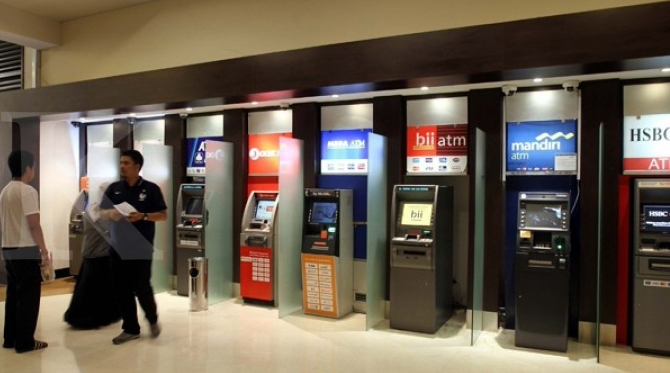
Debit cards are accepted by some ATMs on the Maestro and Cirrus networks. Money is issued in Indonesian rupiah.
ATM machine are sometimes open to the air, sometimes enclosed in a little AC room. On the outside of the machine it will indicate which cards are compatible.
It will also say what denomination the money is dispensed in, either 50,000rp or 100,000rp notes. When you put your card in, you will be asked to select from the Indonesian or English language menu.
After entering your PIN number, you will select what service you need (withdrawal, balance inquiry etc.) and from which account (Saving or Checking).
After about 15 seconds the money is dispensed, then the receipt then the card. Don’t forget to wait for your card.
Bali has around 12 different banks, each with many branches. The most popular are BII, BNI, BCA. Local account holders are able to withdraw money from their bank’s ATMs for free.
Account holders of local backs can withdraw larger sums from ATMs than non-account holders.
For example the maximum amount withdrawal from a BCA ATM is 2.5mrp per session, 2 sessions per day.
Lippo bank allows you to draw out 2m rp per session although the same ATM machine sometimes allows a different rate (figure that out!), which may be something to do with the amount of money left in the machine.
A Silver account with BCA allows a daily withdrawal of 5m rp, a Gold account 10m rp. ATMs vary greatly in the maximum amount they allow you to withdraw. You will be offered a series of amounts and ‘Other Amount’.
By clicking on ‘Other Amount’ and typing the figure, you’ll find out if its possible. If not you’ll be directed to enter a lower figure.
If you are a tourist looking for a friction-free holiday, here are 3 tips for making sure you don’t have a problem using an ATM in Bali – and if you do have a problem, this might help.
- Withdraw cash using major bank ATM’s
- Ask for the location of safe ATM’s
- Go inside the bank for large transactions
Bali Villages
Bali is not just the beaches, Seminyak, and Ubud. There are a lot of thing to explore throughout the island.
Some of the best way to get to know the Balinese culture is to visit its traditional village where you get to see the real Balinese people going about their daily lives. Bali villages are a unique aspect of traditional Balinese life that remains today.
A fascinating part of Bali's culture, most Bali villages are located outside the main tourist areas.
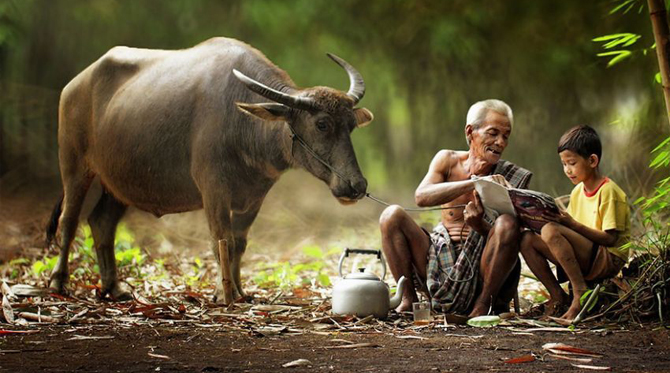
Bali villages are designed around the principal of balance, where humanity and nature meet in harmony.
The basic design philosophy is order with the same mud walls, red tiles, family pavilions and thatched roofs used throughout the villages.
Houses are spaced 30m apart and each Bali village features family temples known as sanggah or merajan as well as community halls called banjars.
Bali villages are known as desas and are located both on the wetlands of the rice paddies and the dry land of gardens, compounds, roads and temples.
Most Bali villages are home to 3 village temples, known as kahyangan tigas and each focuses on a symbolic aspect of life: origin - pura puseh (navel temple), pura desa (territory) and pura dalem (temple of the dead).
Temples are extremely important when it comes to local rituals and ceremonies and these events cannot take place unless a pejati or notification offering has taken place.

Bali villages operate on their own unique social structure with utmost respect shown to traditional village headmen as well as the village committees who make major decisions.
Although traditional Bali villages tend to prefer to operate in privacy, some that are located closer to the major tourist centres allow visitors into the village to learn about the local way of life, see the way native Balinese people live and to observe traditional ceremonies, cooking practices and more.
For an insight into the culture of 'real' Bali, a visit to a traditional Bali village will complete your authentic Bali experience.
Below are the list of the most interesting villages in Bali with their own unique daily life;
1. Trunyan Village - Trunyan or Terunyan is a Balinese village located on the eastern shore of Lake Batur, a caldera lake in Kintamani Regency, central Bali, Indonesia.
Other than as an isolated home of the Bali Aga people, the village is particularly unique for the their tradition in treating the deceased. Instead of burning the bodies, as commonly done for the Hindu Balinese by way of Ngaben (Cremation Ceremony).
The Trunyan people leave dead bodies are placed on ground, simply covered with cloth and bamboo canopies, and left to decompose. The influence of a nearby tree is said to remove the putrid smell of the corpses.
2. Penglipuran Village - This is a traditional Balinese Village located in Bangli Regency, Central Bali, about half an hour’s drive from Gianyar.
Situated about 700 meters above sea level, making a visit to this village a refreshing break from the island heat to the cool mountain breeze. We particularly love Penglipuran for its incredibly clean state.
In fact, this island recently was named as one of the cleanest villages in the world alongside Giethoorn in Netherlands and Mawlynnong in India.
3. Tenganan Village - Desa Tenganan or Tenganan Pegringsingan is a village in Karangasem Bali which before the 1970s was known by anthropologists to be one of the most secluded societies of the archipelago.
It is now one of the very few villages in Bali that still has a well-preserved Bali Aga culture. It still holds to the original traditions, ceremonies and rules of ancient Balinese, its unique village layout and architecture, as well as its Gamelan selunding music and double ikat textiles.
Best time to visit is when they hold the Mekare-Kare tradition every June and Perang Pandan (Pandan leaf war) on July.
Bali Regions
For many people, the name Bali conjures up an image of tropical bliss, sunsets, surf and cocktails on the beach.
Whilst this image is not wrong, it does not do justice to the complexity of Balinese culture, and the sheer richness of experiences to be found on the island.
This is not an easy place to sum up in a single sentence, from the party scene that the south of the island has to offer, to the beautiful rice fields of the central highlands and the sleepy north coast, Bali is a place of contrasts.
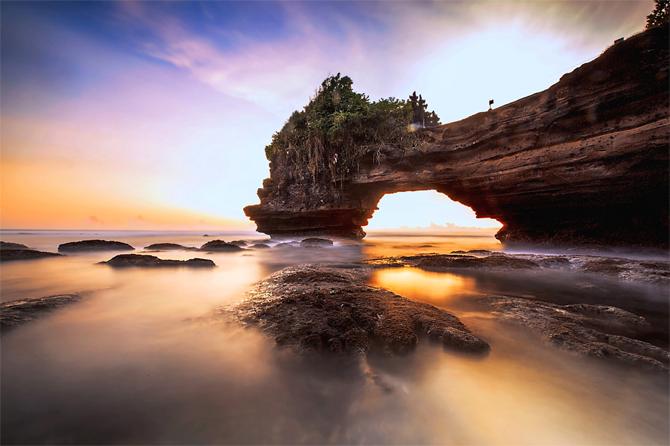
To help you figure out which part of Bali is best for you, here is a quick guide detailing a few of the island’s more well known towns and cities.
- Kuta
Probably the most famous town in Bali and certainly the most infamous! Kuta, as known for its nightlife as it is for its awesome surfing beach, has become the real party town of Bali.The streets are lined with nightclubs and bars and at night the whole place glows neon. The cocktails are cheap, the music is loud and the party goes on until dawn.
Accommodation here runs the gamut from 5 star to cheap backpacker. As for shopping, there are some high-end stores, lots of surf shops and more souvenir stalls.
If you are looking for non-stop action, then Kuta is the town for you, but, if your image of Bali is more of the relaxed, traditional kind, then it may be wise to look elsewhere!
- Seminyak
The long established town of Seminyak is the places to be for all things shopping, gastronomy, family and fun.Known for all things chic and sophisticate, the streets are lined with touristy stalls in other parts of the island are replaced with fancy boutiques selling the latest fashions, stylish home-wares and amazing works of art.
The accommodation here is geared more towards the luxury, although as with most of Bali, there are a few cheaper options if you know where to look.
The nightlife here is cosmopolitan, with some of the best restaurants on the island, expensive cocktail bars and stylish clubs.
A beach stretches along Seminyak’s coast and is dotted with some of the islands best (and biggest) beach bars and cocktail hotspots.
- Canggu
Canggu is the new kid on the block, known as Seminyak’s up and coming neighbor it is now one of the hippest places to be seen in Bali and the destination of choice for all bright young things.Canggu is quieter then Seminyak (although it may not stay that way for long!) and it still retains something of a more traditional feel.
The town is coastal and surrounded by rice fields meaning that even in the middle of things you are never far from a glimpse of nature.
The fantastic surf along this part of the coast has made Canggu into a popular surfing hotspot and its many clubs and restaurants have given it a well-earned reputation as one of the trendiest places to be after dark.
- Nusa Dua & Tanjung Benoa
Whilst the name Nusa Dua can be taken to mean the entire eastern side of the Bukit peninsula, including Tanjung Benoa, it is usually used in reference to a large gated community of luxury resorts.Anyone is free to enter the complex, although there are security checks at the gates. Once inside, you leave behind the chaos of the rest of Bali and enter a world of landscaped gardens and 5 star luxuries.
There is shopping and dining complex called ‘Bali Collection’ that caters only to the tourist market as well as a theatre and surprisingly good art gallery.
Just next door to Nusa Dua is the Tanjung Benoa peninsula. Here you will find a wider range in the quality of accommodation on offer, with a good mix of everything from cheap and cheerful to international 5 star resorts and villas.
Although nowhere near as busy as Kuta, the main road of Jalan Pratama has quite a lively restaurant and bar scene as well as several excellent spas. The relatively calm waters though make the area great for watersports, although surfers should look elsewhere.
As long as the tide is in, the waters are usually thronging with speedboats, jet-skis, banana boats and para-sailors and the coral reef that lies just off the shore provides a good site for snorkelling.
The beach itself is beautiful white sand and has a footpath that runs for about 7km down the length of the peninsula and on into Nusa Dua
- Ubud
Although only about an hour’s drive north of Kuta, Ubud, high up in the mountains, surrounded by paddy fields and lush green forests, may as well be a world away.Ubud is often considered to be the cultural heart of Bali and it has a long association with the arts, which is reflected by the many fine galleries that can be found in the area and the huge amount of arts and crafts stores that line the main road.
As its spiritual reputation would suggest, this is the best place in Bali for yoga and meditation retreats and it has the highest concentration of spas on the island.
The dining scene in Ubud is surprisingly good, the choices range from authentic local food from a warung to world-class international cuisine. During the day there are plenty of healthy cafes, ensuring your body stays as well nurtured as your soul.
Ubud’s nightlife is bit on the quiet side, more bars and bands than thumping nightclubs, but one must do is an evening visit to the royal palace.
The palace is a beautiful building that is well worth a visit in its own right, but at night it regularly comes alive with the sights and sounds of traditional Balinese dance.
Ubud is surrounded by nature, temples and adventure activities (cycling, trekking, whitewater rafting and elephant safari etc.) and its central location makes it a great base from which to explore some of the lesser-known parts of Bali.
- Singaraja & Lovina Beach
These are two of the most famous places along Bali’s north coast, where the pace of life is generally a little sleepier than it is down South.Singaraja is the capital of Bali’s northern most regency, Buleleng, and the second biggest city on the island.
During the period of Dutch colonial rule, Singaraja was their administrative capital and the city, with its wide boulevards and a few remaining colonial buildings, still retains a distinctly more European feel than the rest of Bali.
Whilst not many visitors actually stay in Singaraja, there are a few things to see that make it worth a visit.
The royal palace in Singaraja was originally built in 1604 and is currently open to the public; the descendants of the former rajas still live at the palace.
Giving visitors not only the opportunity to experience high caste Balinese architecture in all its glory but also the chance to mingle with a few royals! Other sites of note include a charming waterfront area and a very ornate Chinese temple.
The most popular place to stay along the north coast is Lovina Beach, which stretches for about 10 kilometers and encompasses 7 traditional villages and plenty of accommodation options for all budgets and lifestyles.
The main focal point is at Kalibukbuk village and is comprised of market stalls, restaurants and enough bars to give the place a bit of nightlife.
The relaxed pace of life does not mean a lack of things to see or do, dolphin watching, diving and snorkelling are all available
And Bali’s biggest Buddhist temple (set in incredibly beautiful gardens) as well as several waterfalls are all easy to get to. The sea is calm, the sand is black and the sunsets are glorious.
- Sanur
Sanur is a bit like the mature older brother of some of the other tourist towns in southern Bali. Its still a fun place to be, but, in general, is a little more refined.The streets are attractive and well cared for and the nightlife tends to wind down around fairly early.
The town center is full of restaurants and shops and the beach is a beautiful strip of white sand.
The waters off Sanur are crystal clear and there are few good spots for diving and snorkelling. Surfers may find one or two breaks, although there are better places elsewhere on the island.
Sanur is not very big and most of its highlights are within easy walking distance of each other.
The town is close enough to Kuta and other well-known spots to ensure that there is always something to see and do but its somewhat less hectic atmosphere makes it a great place to relax with the family.
- Denpasar
Denpasar is the provincial capital and with a population that will soon be approaching a million, it is a very busy place to be!With its tightly packed streets and, at times, oppressive heat, this is not a popular city with tourists but there a are a few museums and historical landmarks that are worth a look.
The Bali Museum, located close to the site of the former royal palace, has an archaeological collection and is one of the better museums in Bali.
The museum is adjacent to Taman Puputan, the main square in Denpasar and the site of a large monument dedicated to the Balinese royal households who were massacred under colonial rule.
- Jimbaran Bay
Earning monikers such as 'Millionaires Row' and the 'Beverly Hills of Bali', Jimbaran Bay offers little budget accommodation.South from the airport and the main town of Kuta, Jimbaran Bay is where you'll find most of Bali's 5 star beach hotels and resorts.
Fantastic surfing and breathtaking natural attractions are the big drawcards to Jimbaran Bay along with its reputation for holidaying in style.
Bali Time
Bali is part of Indonesia. Jakarta is the capital of Indonesia, but it does not share the same time zone with Bali.
Bali time is one hour ahead of Jakarta. Bali shares the same time zone with Singapore, Kuala Lumpur, and Perth (AUS). Sydney is two hours ahead.
Bali is within WITA, Indonesia Central Time Zone (UTC+08:00) WITA or Waktu Indonesia Tengah is 8 hours ahead of UTC, Coordinated Universal Time.
Bali has only one Time Zone. Denpasar, Kuta, Seminyak, Jimbara, Lovina, Gilimanuk, etc. all have the same time.
DST - Daylight Saving Time, Summer Time If you want to remember which way to set the clock think of: “spring forward, fall back”.
This means we set the clock forward in spring when DST starts (= so you lose one hour), and back 1 hour when DST ends in fall (= you regain one hour).
Balinese Cuisine & Food
Balinese cuisine is a cuisine tradition of Balinese people from the volcanic island of Bali. Using a variety of spices, blended with the fresh vegetables, meat and fish.
Part of Indonesian cuisine, it demonstrates indigenous traditions, as well as influences from other Indonesian regional cuisine, Chinese and Indian.
The island's inhabitants are predominantly Hindu and culinary traditions are somewhat distinct with the rest of Indonesia, with festivals and religious celebrations including many special foods prepared as the offerings for the deities, as well as other dishes consumed communally during the celebrations.
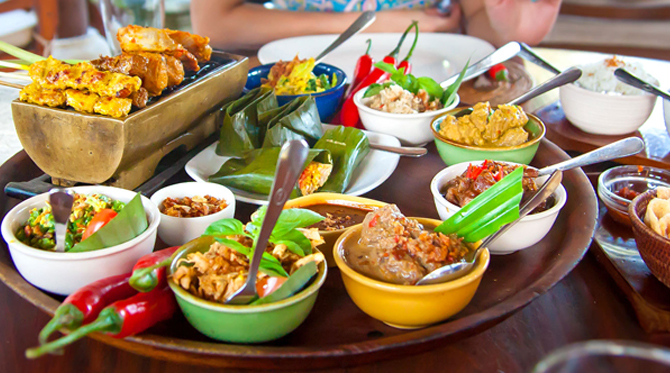
Rice, the primary grain is almost always consumed as a staple accompanied with vegetables, meat and seafood. Pork, chicken, fruit, vegetables and seafood are widely utilized, however just like most of Hindus, beef is never or rarely consumed.
Bali is a popular tourist destination, and the area has quite a lot of cooking schools with daily courses of Balinese cuisine.
Night markets, warungs (food stands), and fruit vendors sell local delicacies. Festivals include ornately prepared foods as part of the celebrations.
As a popular tourist area, many westernized foods are also available as well as other regional ethnic cuisines.
Balinese foods include lawar (chopped coconut, garlic, chilli, with pork or chicken meat and blood), Bebek betutu (duck stuffed with spices, wrapped in banana leaves and coconut husks cooked in a pit of embers).
Balinese sate known as sate lilit made from spiced mince pressed onto skewers which are often lemongrass sticks, Babi guling also known as celeng guling (a spit-roasted pig stuffed with chilli, turmeric, garlic, and ginger).
In Bali, the mixed rice is called nasi campur Bali or simply nasi Bali. The Balinese nasi campur version of mixed rice may have grilled tuna, fried tofu, cucumber, spinach, tempe, beef cubes, vegetable curry, corn, chili sauce on the bed of rice. Mixed rice is often sold by street vendors, wrapped in a banana leaf.
Betutu is eaten in Bali as well as Lombok, and West Nusa Tenggara. It is a roasted poultry dish (chicken or duck) with spices.
Lawar is a traditional vegetable and meat dish in Bali Vegetable and meat dish served with rice. It consists of shredded unripe jackfruit, young banana flower, a liberal amount of pork rind bits, raw pig blood.
These are mashed with herbs such as lemon grass, kaffir lime leaves, shallots, and garlic. Babi guling is a Balinese-style roast pork comparable to Hawaiian luau-style pig.
Other common Indonesian dishes are easily found, such as tempe and tofu are used. Sambal dishes are also served. Bakso, a meatball or meat paste made from beef surimi, can also be found.
Below are the list of the most popular Balinese dishes complement the holiday experience on Bali
1. Sate (Satay) - Sate (or “satay”) are marinated, skewered and grilled meats, served with spicy sauce, and may consist of diced or sliced chicken, goat, mutton, beef, pork, fish, tofu, eggs or minced blends.
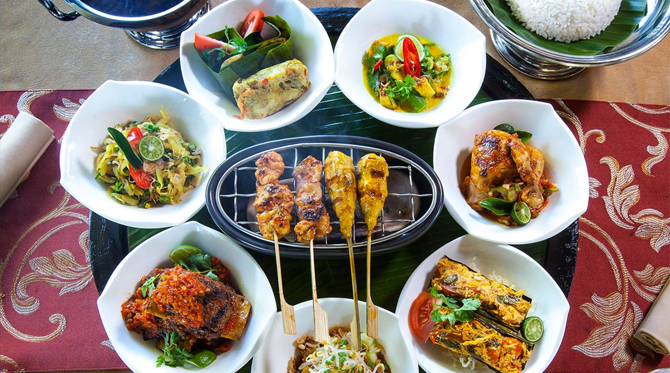
Bali’s own variant is sate lilit, made from minced beef, chicken, fish, pork, or even turtle meat, which is then mixed with coconut, coconut milk, and a rich blend of vegetables and spices.
Wrapped rather than skewered around bamboo, sugar cane or lemongrass sticks then grilled, sate lilit can be enjoyed with or without sauce.
2. Nasi Ayam and Nasi Campur - Bali’s own take on ‘chicken rice’, nasi ayam and nasi campur can be found served at many warungs (small eateries) and restaurants throughout the island.
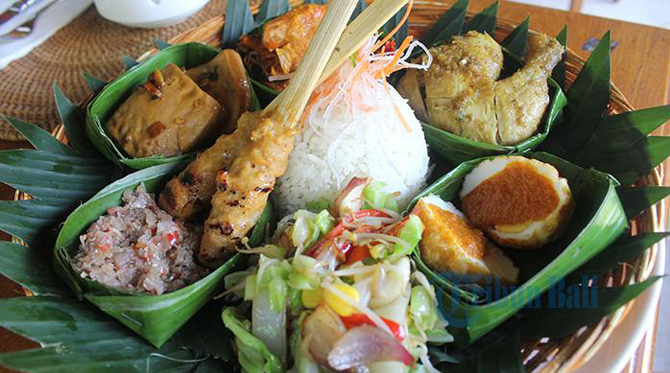
The dish is mainly white rice served with many different elements of Balinese delights, from a bit of babi buling or betutu as the main meats, together with mixed vegetables.
A dab of the iconic spicy hot sambal matah – sometimes served with a bowl of soup. For those who do not want it too spicy, simply ask for it without the sambal.
3. Bebek and Ayam Betutu - Betutu is an iconic Balinese favourite, consisting of a whole chicken or duck stuffed with traditional spices, wrapped in banana leaves, then enveloped tight in banana trunk bark before it’s baked or buried in a coal fire for 6 to 7 hours.
The result is a rich and juicy, succulent feast with all meat easily separated from bones. Betutu is the Balinese slow-cooked luscious equivalent of Babi guling for ‘non-pork eaters’.
4. Babi Guling - Babi guling is an all-time favourite, consisting of spit-roast pig stuffed with rich traditional spices and vegetable mixes such as cassava leaves, slowly ‘rolled’ over (hence its name, guling means ‘to roll’) a coal fire.
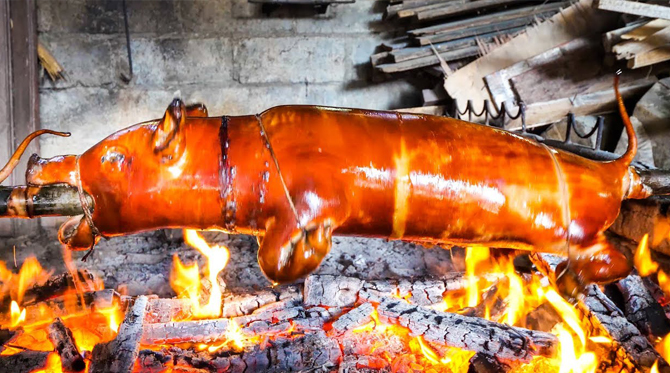
The crisp brown skins are prized, while the meat is a tender and juicy treat. At first the dish was a communal treat only during special festivities and ceremonies, but now babi guling can be found widely served at warungs and restaurants specialising in this dish.
5. Jimbaran Seafood - The line-up of beachside cafés on Muaya beach in Jimbaran Bay typically serves grilled fresh caught seafood, ranging from shrimp, clams, crabs, calamari, lobsters and a wide assortment of fish.
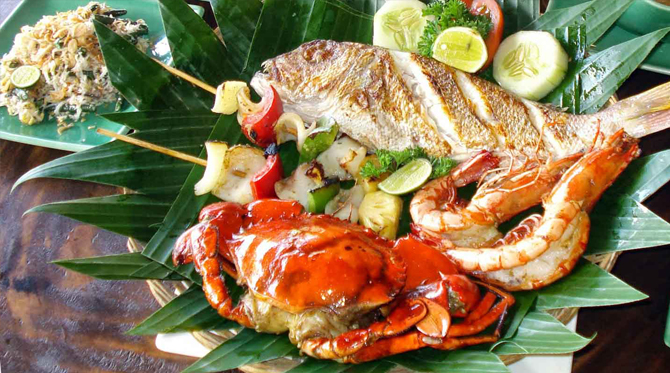
But in terms of taste, the secret lies in each of the café owner’s recipes of barbecue sauce and condiments – usually in the form of homemade sambal,
which has collectively become known as “sambal seafood – Jimbaran style”. From sweet-sour blends to the typical hot and spicy... tasting is believing!.
6. Pepes and Tum - Pepes is an Indonesian Sundanese cooking method using banana-leaf as food wrappings.
The small package is sewed with thin bamboo sticks at both ends, and either steam-cooked, boiled or grilled. It is most commonly used to prepare fish as “pepes ikan” or meat, chicken, tofu or vegetables.
Tum takes on a different form, with the wrapping folded and stitched at one top end, and usually steam-cooked. The banana-leaf wrapping provides a special aromatic appeal to the cooked blend.
7. Lawar - Lawar is a traditional mix containing fine chopped meat, vegetables, grated coconut and spices.
Sometimes, and in some areas, lawar is prepared using fresh blood mixed with the meat and spices to strengthen the flavour. Lawar are usually served immediately after preparation as it cannot be kept long.
There are two main types of lawar, white and red. The white version usually does not contain any meats or blood.
8. Nasi Goreng - Nasi Goreng is Indonesia's fried rice, one of the nation's most notable dishes.
Nasi Goreng is pre-steamed rice stir-fried with a combination of meats and vegetables, ranging from scrambled eggs, diced beef, strips of chicken, shrimp, anchovies, lamb, crab, green peas, onions, shallots and a blend of sweet soy sauce or kecap manis and hot chili sauce.
The presentation usually features the typical toppings: sliced tomatoes and/or cucumber, fried shallots, fish or shrimp krupuk crackers and mixed pickles or acar.
Bali Emergency and Rescue Numbers
Bali Emergency and Rescue Assistance will help you to contact the right person if you have an emergency during your Bali holiday.
The main emergency number in Bali is 112. It’s similar to the North American Rescue 911 Hotline.
However, unlike 911, when you’re calling 112 you need to include a country and area code if you’re using a foreign SIM.

If you are using a local SIM, you should dial 0361 first then the emergency number. If your SIM is international, you should dial +62 361 first then the emergency number.
If you are using a local landline, you may simply dial the emergency number directly.
Police stations and hospitals staff in the main tourist regions usually speak and understand English. If you’re in a remote area, it’s best to have someone who can speak the local language.
If you need to take someone to the hospital quickly, it could be better to take a cab rather than wait for the ambulance.
In case of Emergency You need to be aware of dialing procedures, how to use the local area codes when calling the emergency assistance services listed below.
In hospitals and police stations in the south near the main tourism areas, people will understand you, when you speak in English.
If you need assistance in a remote area, you should bring somebody along who speaks Indonesian.
Here are the main numbers you can call during an emergeny:
Planning Your Vacation to Bali?
Let Check it out! — Cheap & Best Bali Tour Packages?
Dear lovely guests, the Bali Cheapest Tours is a small tour operator in Bali, that focuses on creating memorable & unique experiences around Bali, Indonesia
Our job is not just to sell tours that will let travelers know the culture, history, traditions and the magnificent nature of this island. And our team is composed of fun, local experts guides. We love meeting new people from around the world and helping them capture amazing photos and experience our local culture.
Our promise to you is that you will always be treated as family. We’re sure you will have a fun, safe and unique experience that you won’t find anywhere else.
